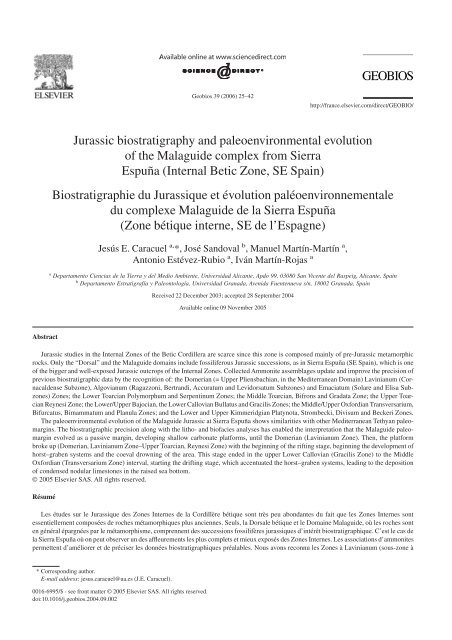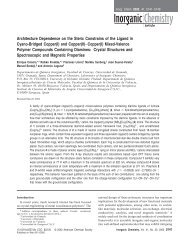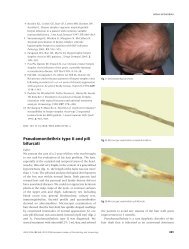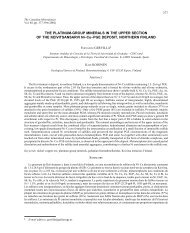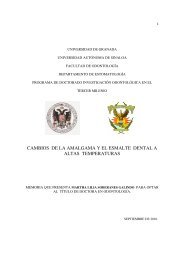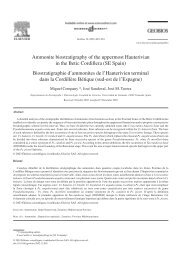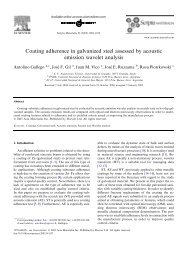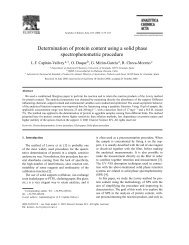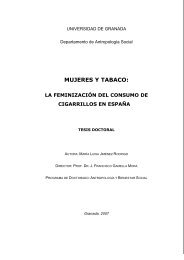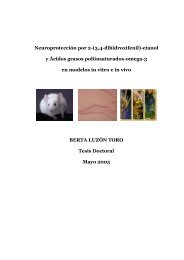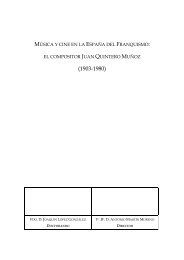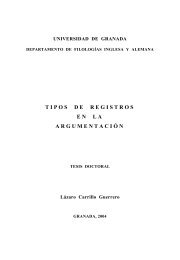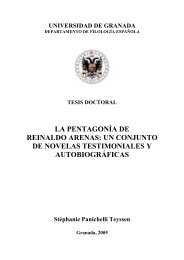Jurassic biostratigraphy and paleoenvironmental evolution of the ...
Jurassic biostratigraphy and paleoenvironmental evolution of the ...
Jurassic biostratigraphy and paleoenvironmental evolution of the ...
You also want an ePaper? Increase the reach of your titles
YUMPU automatically turns print PDFs into web optimized ePapers that Google loves.
Abstract<br />
<strong>Jurassic</strong> <strong>biostratigraphy</strong> <strong>and</strong> <strong>paleoenvironmental</strong> <strong>evolution</strong><br />
<strong>of</strong> <strong>the</strong> Malaguide complex from Sierra<br />
Espuña (Internal Betic Zone, SE Spain)<br />
Biostratigraphie du Jurassique et évolution paléoenvironnementale<br />
du complexe Malaguide de la Sierra Espuña<br />
(Zone bétique interne, SE de l’Espagne)<br />
Jesús E. Caracuel a, *, José S<strong>and</strong>oval b , Manuel Martín-Martín a ,<br />
Antonio Estévez-Rubio a , Iván Martín-Rojas a<br />
a Departamento Ciencias de la Tierra y del Medio Ambiente, Universidad Alicante, Apdo 99, 03080 San Vicente del Raspeig, Alicante, Spain<br />
b Departamento Estratigrafía y Paleontología, Universidad Granada, Avenida Fuentenueva s/n, 18002 Granada, Spain<br />
Received 22 December 2003; accepted 28 September 2004<br />
Available online 09 November 2005<br />
<strong>Jurassic</strong> studies in <strong>the</strong> Internal Zones <strong>of</strong> <strong>the</strong> Betic Cordillera are scarce since this zone is composed mainly <strong>of</strong> pre-<strong>Jurassic</strong> metamorphic<br />
rocks. Only <strong>the</strong> “Dorsal” <strong>and</strong> <strong>the</strong> Malaguide domains include fossiliferous <strong>Jurassic</strong> successions, as in Sierra Espuña (SE Spain), which is one<br />
<strong>of</strong> <strong>the</strong> bigger <strong>and</strong> well-exposed <strong>Jurassic</strong> outcrops <strong>of</strong> <strong>the</strong> Internal Zones. Collected Ammonite assemblages update <strong>and</strong> improve <strong>the</strong> precision <strong>of</strong><br />
previous biostratigraphic data by <strong>the</strong> recognition <strong>of</strong>: <strong>the</strong> Domerian (= Upper Pliensbachian, in <strong>the</strong> Mediterranean Domain) Lavinianum (Cornacaldense<br />
Subzone), Algovianum (Ragazzoni, Bertr<strong>and</strong>i, Accuratum <strong>and</strong> Levidorsatum Subzones) <strong>and</strong> Emaciatum (Solare <strong>and</strong> Elisa Subzones)<br />
Zones; <strong>the</strong> Lower Toarcian Polymorphum <strong>and</strong> Serpentinum Zones; <strong>the</strong> Middle Toarcian, Bifrons <strong>and</strong> Gradata Zone; <strong>the</strong> Upper Toarcian<br />
Reynesi Zone; <strong>the</strong> Lower/Upper Bajocian, <strong>the</strong> Lower Callovian Bullatus <strong>and</strong> Gracilis Zones; <strong>the</strong> Middle/Upper Oxfordian Transversarium,<br />
Bifurcatus, Bimammatum <strong>and</strong> Planula Zones; <strong>and</strong> <strong>the</strong> Lower <strong>and</strong> Upper Kimmeridgian Platynota, Strombecki, Divisum <strong>and</strong> Beckeri Zones.<br />
The <strong>paleoenvironmental</strong> <strong>evolution</strong> <strong>of</strong> <strong>the</strong> Malaguide <strong>Jurassic</strong> at Sierra Espuña shows similarities with o<strong>the</strong>r Mediterranean Tethyan paleomargins.<br />
The biostratigraphic precision along with <strong>the</strong> litho- <strong>and</strong> bi<strong>of</strong>acies analyses has enabled <strong>the</strong> interpretation that <strong>the</strong> Malaguide paleomargin<br />
evolved as a passive margin, developing shallow carbonate platforms, until <strong>the</strong> Domerian (Lavinianum Zone). Then, <strong>the</strong> platform<br />
broke up (Domerian, Lavinianum Zone–Upper Toarcian, Reynesi Zone) with <strong>the</strong> beginning <strong>of</strong> <strong>the</strong> rifting stage, beginning <strong>the</strong> development <strong>of</strong><br />
horst–graben systems <strong>and</strong> <strong>the</strong> coeval drowning <strong>of</strong> <strong>the</strong> area. This stage ended in <strong>the</strong> upper Lower Callovian (Gracilis Zone) to <strong>the</strong> Middle<br />
Oxfordian (Transversarium Zone) interval, starting <strong>the</strong> drifting stage, which accentuated <strong>the</strong> horst–graben systems, leading to <strong>the</strong> deposition<br />
<strong>of</strong> condensed nodular limestones in <strong>the</strong> raised sea bottom.<br />
© 2005 Elsevier SAS. All rights reserved.<br />
Résumé<br />
Les études sur le Jurassique des Zones Internes de la Cordillère bétique sont très peu abondantes du fait que les Zones Internes sont<br />
essentiellement composées de roches métamorphiques plus anciennes. Seuls, la Dorsale bétique et le Domaine Malaguide, où les roches sont<br />
en général épargnées par le métamorphisme, comprennent des successions fossilifères jurassiques d’intérêt biostratigraphique. C’est le cas de<br />
la Sierra Espuña où on peut observer un des affleurements les plus complets et mieux exposés des Zones Internes. Les associations d’ammonites<br />
permettent d’améliorer et de préciser les données biostratigraphiques préalables. Nous avons reconnu les Zones à Lavinianum (sous-zone à<br />
* Corresponding author.<br />
E-mail address: jesus.caracuel@ua.es (J.E. Caracuel).<br />
0016-6995/$ - see front matter © 2005 Elsevier SAS. All rights reserved.<br />
doi:10.1016/j.geobios.2004.09.002<br />
Geobios 39 (2006) 25–42<br />
http://france.elsevier.com/direct/GEOBIO/
26 J.E. Caracuel et al. / Geobios 39 (2006) 25–42<br />
Cornacaldense), Algovianum (sous-zones à Ragazzoni, Bertr<strong>and</strong>i, Accuratum et Levidorsatum) et Emaciatum (sous-zones à Solare et Elisa)<br />
dans le Domérien; les zones à Polymorphum et Serpentinum dans le Toarcien inférieur ; les Zones à Bifrons et Gradata dans le Toarcien moyen<br />
et la Zone à Reynesi dans le Toarcien supérieur ; la partie supérieur du Bajocien inférieur et le Bajocien supérieur ; le Callovien inférieur,<br />
Zones à Bullatus et Gracilis ; les Zones à Transversarium, Bifurcatus, Bimammatum et Planula dans l’Oxfordien moyen/supérieur et les Zones<br />
à Platynota, Strombecki, Divisum et Beckeri dans le Kimméridgien.<br />
L’évolution de l’environnement du Jurassique Malaguide dans la Sierra Espuña montre beaucoup d’affinités avec les autres paléomarges<br />
de la Téthys méditerranéenne. La précision biostratigraphique et l’analyse des lith<strong>of</strong>aciès et des bi<strong>of</strong>aciès nous ont permis d’interpréter la<br />
paléomarge Malaguide comme une paléomarge passive, avec le développement d’une plate-forme carbonatée sommaire jusqu’au Domérien<br />
(Zone à Lavinianum). Ensuite eut lieu la fracturation de cette plate-forme (Domérien inférieur, Zone à Levinianum-Toarcien supérieur, Zone<br />
à Reynesi) liée au commencement de la phase de « rifting », caractérisée par le développement d’un système de horsts et grabens et l’enfoncement<br />
de cette région. L’extension se poursuit entre le Callovien inférieur (Zone à Gracilis) et l’Oxfordien Moyen (Zone à Transversarium), en<br />
indiquant le début d’une phase de « drifting » qui aurait déclenché la réactivation du système de horsts et grabens, conduisant au dépôt de<br />
calcaires nodulaires condensés dans les parties les plus élevées du fond marin.<br />
© 2005 Elsevier SAS. All rights reserved.<br />
Keywords: <strong>Jurassic</strong>; Ammonite <strong>biostratigraphy</strong>; Paleoenvironmental <strong>evolution</strong>; Internal Betic Zone; Malaguide Complex; Sou<strong>the</strong>astern Spain<br />
Mots clés : Jurassique ; Biostratigraphie des ammonites ; Évolution de l’environnement ; Zone Interne Bétique ; Complexe Malaguide ; Sud-Est de l’Espagne<br />
1. Introduction<br />
The <strong>Jurassic</strong> <strong>evolution</strong> <strong>of</strong> <strong>the</strong> Betic Cordillera took place<br />
under distensive tectonic conditions related to Tethyan rifting.<br />
Although, <strong>the</strong> rifting age has been considered quite similar<br />
throughout <strong>the</strong> cordillera, controversy continues concerning<br />
<strong>the</strong> synchronism versus diachronism for <strong>the</strong> pre-, syn<strong>and</strong><br />
postrifting periods in <strong>the</strong> different domains into which<br />
<strong>the</strong> Betic Cordillera has traditionally been divided: <strong>the</strong> Internal<br />
<strong>and</strong> <strong>the</strong> External Zones.<br />
The External Zones belong to <strong>the</strong> South Iberian Paleomargin<br />
<strong>and</strong> consist <strong>of</strong> post-Triassic unmetamorphosed rocks.<br />
Thus, <strong>the</strong> <strong>Jurassic</strong> paleogeographic <strong>evolution</strong> <strong>and</strong> <strong>the</strong> age <strong>of</strong><br />
<strong>the</strong> onset <strong>of</strong> <strong>the</strong> rifting (Carixian = Lower Pliensbachian), <strong>and</strong><br />
<strong>the</strong> post-rifting phase (boundary Middle/Upper <strong>Jurassic</strong>) has<br />
been well-characterized (Vera, 1988). On <strong>the</strong> contrary, <strong>the</strong><br />
Internal Betic Zones belong to a microplate (Mesomediterranean<br />
Terrain, Guerrera et al., 1993) derived from <strong>the</strong> North<br />
African continental margin, which collided against <strong>the</strong> External<br />
Zones during <strong>the</strong> Early Miocene. These zones are built up<br />
by <strong>the</strong> stacking <strong>of</strong> four complexes (in order upwards): Nevad<strong>of</strong>ilabride,<br />
Alpujarride, Malaguide <strong>and</strong> “Dorsal”. The Nevad<strong>of</strong>ilabride<br />
<strong>and</strong> Alpujarride are composed mainly <strong>of</strong> Paleozoic<br />
<strong>and</strong> Triassic (<strong>and</strong> older), metamorphic rocks, while <strong>the</strong><br />
Malaguide <strong>and</strong> “Dorsal” Complexes include unmetamorphosed<br />
Paleozoic (Malaguide) <strong>and</strong> Meso-Cenozoic (Malaguide<br />
<strong>and</strong> “Dorsal”) sedimentary rocks. In general, <strong>the</strong> scarcity<br />
<strong>of</strong> <strong>Jurassic</strong> unmetamorphosed successions, toge<strong>the</strong>r with <strong>the</strong><br />
intense tectonic activity, have hampered <strong>the</strong> dating <strong>of</strong> <strong>the</strong> main<br />
<strong>Jurassic</strong> events in <strong>the</strong> Internal Zones.<br />
The Malaguide is <strong>the</strong> uppermost Complex (<strong>and</strong>, consequently,<br />
<strong>the</strong> most internal) <strong>of</strong> <strong>the</strong> Internal Zones, which outcrops<br />
mainly from Malaga Province (westward) to Murcia<br />
Province (eastward). In contrast to <strong>the</strong> o<strong>the</strong>r complexes, <strong>the</strong><br />
Malaguide Complex includes <strong>Jurassic</strong> sedimentary covers,<br />
favoring <strong>the</strong> analysis <strong>of</strong> <strong>the</strong> <strong>Jurassic</strong> <strong>evolution</strong> <strong>of</strong> <strong>the</strong> Internal<br />
Betic Zones. The Sierra Espuña area, in Murcia Province, is<br />
probably <strong>the</strong> most extensive, <strong>and</strong> <strong>the</strong> best exposed <strong>Jurassic</strong><br />
outcrop belonging to <strong>the</strong> Malaguide in <strong>the</strong> Betic Cordillera.<br />
Except for <strong>the</strong> pioneer work by Fallot (1945), <strong>the</strong> main<br />
papers on <strong>the</strong> <strong>Jurassic</strong> <strong>of</strong> Sierra Espuña are from <strong>the</strong> 1960s<br />
<strong>and</strong> 1970s (Peyre <strong>and</strong> Peyre, 1960; Mac Gillavry et al., 1963;<br />
Navarro <strong>and</strong> Trigueros, 1963; Paquet, 1962, 1969; Geyer <strong>and</strong><br />
Hinkelbein, 1971, 1974; Kampchuur et al., 1974; Seyfried,<br />
1978, among o<strong>the</strong>rs). Almost no recent studies have been<br />
made on <strong>the</strong> <strong>biostratigraphy</strong> <strong>and</strong> <strong>the</strong> paleogeographic <strong>evolution</strong><br />
<strong>of</strong> <strong>the</strong> <strong>Jurassic</strong> <strong>of</strong> Sierra Espuña. In <strong>the</strong> present work, we<br />
analyze some classical <strong>Jurassic</strong> sections, toge<strong>the</strong>r with new<br />
sections, in order to update <strong>the</strong> biostratigraphic framework<br />
<strong>and</strong> to approach <strong>the</strong> <strong>paleoenvironmental</strong> <strong>evolution</strong> <strong>of</strong> <strong>the</strong><br />
<strong>Jurassic</strong> Malaguide from Sierra Espuña. Moreover, this will<br />
improve <strong>the</strong> knowledge <strong>of</strong> <strong>the</strong> <strong>Jurassic</strong> <strong>of</strong> <strong>the</strong> Internal Betic<br />
Zones, in addition to providing a fuller underst<strong>and</strong>ing <strong>of</strong> <strong>the</strong><br />
External Betic Zones, <strong>and</strong> <strong>the</strong>ir relationships.<br />
2. Geographical <strong>and</strong> geological setting<br />
The Sierra Espuña area is located in Murcia Province,<br />
accessible by road from <strong>the</strong> villages <strong>of</strong> Alhama <strong>and</strong> Totana,<br />
from <strong>the</strong> south, <strong>and</strong> Mula from <strong>the</strong> north (Fig. 1). The Malaguide<br />
outcropping area <strong>of</strong> Sierra Espuña bounds tectonically<br />
with <strong>the</strong> Alpujarride Complex to <strong>the</strong> SE, <strong>and</strong> with <strong>the</strong> External<br />
Betic Zones (Subbetic) to <strong>the</strong> NW. Laterally, <strong>the</strong> nearest<br />
outcrop <strong>of</strong> <strong>Jurassic</strong> Malaguide in <strong>the</strong> region is located 40 km<br />
westward, near Vélez Rubio in <strong>the</strong> Province <strong>of</strong> Almeria<br />
(Castillón Fm., Geel, 1973).<br />
The outcropping Malaguide Complex in Sierra Espuña is<br />
composed <strong>of</strong> two tectonic units (Martín-Martín, 1996); Morrón<br />
de Totana <strong>and</strong> Perona (Fig. 1). The Morrón de Totana<br />
Unit is <strong>the</strong> footwall while <strong>the</strong> Perona Unit is <strong>the</strong> hanging wall,<br />
which, paleogeographically came from a more proximal position<br />
(Martín-Martín <strong>and</strong> Martín-Algarra, 1997). Both units<br />
include a marine <strong>Jurassic</strong> sedimentary cover, although in <strong>the</strong>
Perona Unit only outcrops Liassic sediments <strong>and</strong> have a<br />
reduced areal extension. In this unit, only one section was<br />
selected for studying (Perona section; Fig. 1). In <strong>the</strong> Morrón<br />
de Totana Unit, <strong>the</strong> <strong>Jurassic</strong> is well developed, outcropping<br />
with lateral continuity along more than 12 km (Fig. 1). Here,<br />
four sections were analyzed, <strong>the</strong>se being spaced 2–5 km from<br />
each o<strong>the</strong>r in an E-W direction (Malvariche, Tres Carrascas,<br />
Prat Mayor <strong>and</strong> Morrón Chico sections; Fig. 1).<br />
J.E. Caracuel et al. / Geobios 39 (2006) 25–42<br />
Fig. 1. Geographical (upper) <strong>and</strong> Geological (lower) sketches with <strong>the</strong> location <strong>of</strong> <strong>the</strong> 5 studied sections at Sierra Espuña. Legend: 1. Undifferentiated Quaternary.<br />
2. Eocene platform carbonates. 3. Lower Cretaceous marls <strong>and</strong> marly limestones. 4. Upper <strong>Jurassic</strong> marl, limestones <strong>and</strong> nodular limestones. 5. Domerian–<br />
Lower Callovian cherty rhythmic limestones. 6. Liassic p.p. shallow water limestones. 7. Triassic/Liassic? Dolostones. 8. Triassic conglomerates <strong>and</strong> s<strong>and</strong>stones.<br />
Fig. 1. Croquis géographique (supérieur) et géologique (inférieur) avec l’emplacement des 5 sections étudiées dans la Sierra Espuña. Légende : 1. Quaternaire<br />
indifférencié. 2. Plate-forme carbonatée éocène. 3. Marnes et calcaires marneux du Crétacé inférieur. 4. Marnes, calcaires et calcaires noduleux du Jurassique<br />
supérieur. 5. Calcaires rythmiques à silex du Domérien inférieur - Callovien. 6. Calcaires d’eaux peu pr<strong>of</strong>ondes du Lias p.p. 7. Dolomies du Trias/Lias?. 8.<br />
Conglomérats et sables du Trias.<br />
3. State-<strong>of</strong>-<strong>the</strong>-art <strong>Jurassic</strong> Malaguide at Sierra Espuña<br />
The first relevant data on <strong>the</strong> <strong>Jurassic</strong> from Sierra Espuña<br />
come from Fallot (1929, 1945), who studied <strong>the</strong> <strong>Jurassic</strong> successions<br />
at Morrón Chico <strong>and</strong> Prat Mayor. This author recognized,<br />
within <strong>the</strong> carbonate succession <strong>of</strong> <strong>the</strong> platform, a<br />
ferruginous oolith-rich interval (0.5–3 m thick) with late Liassic<br />
ammonites (Dumortieria sp. <strong>and</strong> Pleydellia sp.). This<br />
27
28 J.E. Caracuel et al. / Geobios 39 (2006) 25–42<br />
guide-level was first noted by Villasante (1912), who assigned<br />
it a Lusitanian to Kimmeridgian age.<br />
Later on, Peyre <strong>and</strong> Peyre (1960) <strong>and</strong> Navarro <strong>and</strong><br />
Trigueros (1963) fixed <strong>the</strong> age <strong>of</strong> <strong>the</strong> ferruginous oolith-rich<br />
interval studied by Fallot (1945), based on <strong>the</strong> faunas (ammonites<br />
<strong>and</strong> brachiopods) collected in <strong>the</strong> Prat Mayor section.<br />
Peyre <strong>and</strong> Peyre (1960) recognized abundant ammonites <strong>of</strong><br />
<strong>the</strong> genera Lytoceras, Coeloceras, Reynesoceras, Arieticeras,<br />
Harpoceras <strong>and</strong> Protogrammoceras, <strong>and</strong> brachiopods<br />
(Spiriferina, Terebratula <strong>and</strong> Rhynchonella), <strong>and</strong> used<br />
<strong>the</strong>m to date <strong>the</strong> Middle Domerian (Domerian = Upper Pliensbachian,<br />
in <strong>the</strong> Mediterranean Domain). No more macr<strong>of</strong>auna<br />
was collected in <strong>the</strong> remaining <strong>Jurassic</strong> succession,<br />
although <strong>the</strong> record <strong>of</strong> micr<strong>of</strong>acies enriched in crinoids, foraminifers<br />
(Involutina, Nodosaria <strong>and</strong> Lenticulina), Stomiosphaera<br />
<strong>and</strong> Cadosina toward <strong>the</strong> upper part, make feasible<br />
to assume <strong>the</strong> existence <strong>of</strong> <strong>the</strong> Middle <strong>and</strong> Upper <strong>Jurassic</strong>, as<br />
in <strong>the</strong> section at Morrón Chico studied by Fallot (1945).<br />
The syn<strong>the</strong>sis by Paquet (1969), <strong>and</strong> precursor works<br />
(Paquet, 1962), are <strong>the</strong> most exhaustive studies <strong>of</strong> <strong>the</strong> <strong>Jurassic</strong><br />
from Sierra Espuña, including <strong>the</strong> analysis <strong>of</strong> sections in<br />
<strong>the</strong> Morrón de Totana <strong>and</strong> Perona tectonic units. According<br />
to Peyre <strong>and</strong> Peyre (1960) <strong>and</strong> Paquet (1969) proposed a<br />
Middle Domerian (Upper Pliensbachian) age for <strong>the</strong> ferruginous<br />
oolith-rich level <strong>of</strong> <strong>the</strong> Liassic in <strong>the</strong> Prat Mayor section,<br />
based on <strong>the</strong> record <strong>of</strong> Fuciniceras cf. curionii (Meneghini),<br />
Protogrammoceras bassanii (Fucini), Arieticeras<br />
bertr<strong>and</strong>i (Kilian) <strong>and</strong> Ar. fuccinii (Del Campana), among<br />
o<strong>the</strong>rs. In <strong>the</strong> Perona section, <strong>the</strong> same level was dated by<br />
Paquet, using brachiopods as Lower Pliensbachian, leading<br />
to <strong>the</strong> suggestion that <strong>the</strong> ferruginous oolith-rich interval might<br />
be diachronous.<br />
According to Paquet (1969), <strong>the</strong> Lower/Middle <strong>Jurassic</strong><br />
boundary in <strong>the</strong> Morrón de Totana Unit (probably studied in<br />
<strong>the</strong> Prat Mayor section), begins with a thick oolitic-limestone<br />
level (25 m) with gastropods <strong>and</strong> bivalve fragments, evolving<br />
to whitish-gray micritic limestones with filaments (10 m), <strong>and</strong><br />
later on, well-bedded gray, slightly marly, pelagic limestones<br />
(25 m) with “Cancellophycus”, filaments, <strong>and</strong> Globochaete<br />
alpina Lombard belonging to <strong>the</strong> Middle <strong>Jurassic</strong>. In <strong>the</strong><br />
Upper <strong>Jurassic</strong> analyzed in <strong>the</strong> same localities, including <strong>the</strong><br />
Fuente Blanca section (here called Prat Mayor), Paquet (1969)<br />
recognized well-bedded gray limestones with filaments at <strong>the</strong><br />
base, slightly marly limestones with Globochaete above <strong>and</strong><br />
grayish-white, more or less nodular, limestones with Calpionella<br />
alpina Lorenz, Stomiosphera minutissima (Colom),<br />
G. alpina Lombard, Textulariidae <strong>and</strong> Lageniidae towards<br />
<strong>the</strong> upper part.<br />
Geyer <strong>and</strong> Hinkelbein (1971, 1974) focused on <strong>the</strong> detailed<br />
<strong>biostratigraphy</strong> <strong>of</strong> <strong>the</strong> Liassic ferruginous oolith-rich interval,<br />
outcropping in <strong>the</strong> Morrón de Totana (Morrón de Alhama<br />
section, for <strong>the</strong>se authors) <strong>and</strong> Prat Mayor (Fuente Blanca<br />
section, for <strong>the</strong>se authors). Geyer <strong>and</strong> Hinkelbein (1971, 1974)<br />
made a detailed correlation <strong>of</strong> this 5 m thick section, dating it<br />
as <strong>the</strong> Upper Pliensbachian (on <strong>the</strong> basis <strong>of</strong> a few <strong>and</strong> badly<br />
preserved forms <strong>of</strong> Arieticeras/Canavaria/Fontanelliceras,<br />
Lioceratoides <strong>and</strong> Catacoeloceras) in <strong>the</strong> lower part <strong>of</strong> Prat<br />
Mayor section. In <strong>the</strong> upper part <strong>of</strong> Morrón de Totana section,<br />
it was dated as <strong>the</strong> Middle Toarcian [Peronoceras cf.<br />
millarense Monestier, Catacoeloceras tethysi Géczy,<br />
Hildoceras cf. graecum Renz, Hi. cf. bifrons (Bruguière),<br />
among o<strong>the</strong>rs], <strong>and</strong> <strong>the</strong> Upper Toarcian [Hugia cf. variabilis<br />
(d’Orbigny), Grammoceras thouarsense (d’Orbigny), Dumortieria<br />
sp. <strong>and</strong> Pleydellia sp., as more relevant]. Thus, <strong>the</strong>se<br />
authors assumed an Upper Pliensbachian–Aalenian? age for<br />
<strong>the</strong> complete interval in both sections, avoiding <strong>the</strong> interpretation<br />
<strong>of</strong> <strong>the</strong> diachroneity proposed by Paquet (1962, 1969).<br />
Kampchuur et al. (1974) assigned 90 m <strong>of</strong> white oolitic<br />
limestones with algae (Thaumatoporella), ostracods, <strong>and</strong> foraminifers<br />
to <strong>the</strong> pre-Domerian Liassic. Over <strong>the</strong>se shallow platform<br />
carbonates appear a few meters <strong>of</strong> ferruginous oolithrich<br />
limestones. These authors accepted <strong>the</strong> dating by Paquet<br />
(1969) for this guide horizon as Middle Domerian in <strong>the</strong> Morrón<br />
de Totana Unit, <strong>and</strong> <strong>the</strong>n <strong>the</strong> subsequent diachrony <strong>of</strong><br />
such level. The Dogger encompasses 100–140 m thick <strong>of</strong><br />
oolitic limestones with crinoids, miliolids <strong>and</strong> ostracods,<br />
evolving to biopelmicrites, rich in echinoderms, “filaments”,<br />
Ammodiscus, <strong>and</strong> lagenids. The Upper <strong>Jurassic</strong> is composed<br />
<strong>of</strong> 90 m <strong>of</strong> massive limestones, occasionally nodular, with<br />
radiolaria, Globuligerina, G. alpina Lombard, <strong>and</strong> ostracods,<br />
with Saccocoma <strong>and</strong> calpionellids in its upper part.<br />
Seyfried (1978) studied some <strong>Jurassic</strong> sections at Casas y<br />
Pozos de Murcia (equivalent, in part to <strong>the</strong> Prat Mayor <strong>and</strong><br />
Tres Carrascas sections here) recognizing <strong>the</strong> ferruginous<br />
oolith-rich level with abundant Middle Domerian faunas. The<br />
Middle <strong>Jurassic</strong> materials are represented by 65–70 m <strong>of</strong><br />
oolitic/crinoidal limestones, <strong>and</strong> gray laminated limestones<br />
containing trace fossils, interbedded with turbiditic levels with<br />
resedimented oolites <strong>and</strong> scarce Upper Bajocian ammonites<br />
(Spiroceras sp., Nannolytoceras sp.). The overlying Upper<br />
<strong>Jurassic</strong> (approximately 45 m thick) includes calcareous breccias,<br />
pelites <strong>and</strong> fluxoturbidites with foraminifers, bivalves<br />
(Inoceramus) <strong>and</strong> Oxfordian ammonites (Phylloceras sp.,<br />
Holcophylloceras sp., Sowerbyceras sp., Arisphinctes sp. <strong>and</strong><br />
Dichotomosphinctes? sp.) at its base, with massive limestones<br />
above <strong>and</strong> well bedded limestones (pelmicrosparite <strong>and</strong><br />
biopelmicrite) with foraminifers, crinoids, <strong>and</strong> echinoids in<br />
its upper part.<br />
Recently, Caracuel et al. (2001) <strong>and</strong> Martín-Rojas et al.<br />
(2002) described <strong>the</strong> general stratigraphy <strong>of</strong> a new <strong>Jurassic</strong><br />
section near Malvariche, where <strong>the</strong> lith<strong>of</strong>acies are similar to<br />
those <strong>of</strong> <strong>the</strong> classical outcrops at Prat Mayor <strong>and</strong> Morrón<br />
Chico. In <strong>the</strong> Malvariche section, <strong>the</strong>se authors found ammonite<br />
assemblages indicating <strong>the</strong> Middle Domerian (Algovianum<br />
Zone; ferruginous oolith-rich limestones), <strong>the</strong><br />
Lower Callovian [Bullatus <strong>and</strong> Gracilis (= Patina zone, sensu<br />
Sequeiros, 1974)], <strong>and</strong> <strong>the</strong> uppermost Kimmeridgian (Beckeri<br />
Zone).<br />
4. The sections studied: stratigraphic data<br />
Five <strong>Jurassic</strong> sections were studied in Sierra Espuña; <strong>the</strong><br />
three classical sections already mentioned from Fallot (1945)
to Seyfried (1978); Prat Mayor, Morrón Chico <strong>and</strong> Perona,<br />
(Fig. 1), <strong>and</strong> two new ones (Malvariche <strong>and</strong> Tres Carrascas<br />
sections; Fig. 1). Sections were selected to cover <strong>the</strong> Morrón<br />
de Totana tectonic Unit (Malvariche, Tres Carrascas, Prat<br />
Mayor <strong>and</strong> Morrón Chico sections; Figs. 1–3) <strong>and</strong> <strong>the</strong> Perona<br />
Unit (Perona section; Figs. 1 <strong>and</strong> 3), evenly spaced along <strong>the</strong><br />
Sierra Espuña.<br />
The present study was focused in <strong>the</strong> Prat Mayor <strong>and</strong> Malvariche<br />
sections (Fig. 2) since <strong>the</strong>y are easily accessible, are<br />
little tectonized <strong>and</strong> contain <strong>the</strong> most complete, <strong>and</strong> fossilrich<br />
successions. In sections at Tres Carrascas, Morrón Chico<br />
<strong>and</strong> Perona, only <strong>the</strong> Liassic (especially <strong>the</strong> ferruginous oolithrich<br />
limestone interval) was studied.<br />
Along with <strong>the</strong> stratigraphical <strong>and</strong> sedimentological analysis,<br />
more than 140 thin sections were used for characterizing<br />
<strong>the</strong> micr<strong>of</strong>acies, textures <strong>and</strong> micr<strong>of</strong>ossil content; particularly<br />
<strong>the</strong> Globuligerina <strong>and</strong> calpionellids, during <strong>the</strong> Upper<br />
<strong>Jurassic</strong>, which have potential biostratigraphic interest. Macroinvertebrates<br />
(more than 500 specimens), mainly ammonites<br />
<strong>and</strong> brachiopods, were sampled in favorable facies for<br />
<strong>biostratigraphy</strong>.<br />
4.1. Lower <strong>Jurassic</strong><br />
The Lower <strong>Jurassic</strong> was analyzed in all sections studied. It<br />
is composed <strong>of</strong> oo-oncolitic limestones, sometimes brecciated,<br />
evolving to crinoidal limestones, with an interval <strong>of</strong> ferruginous<br />
silty limestones at <strong>the</strong> top. In <strong>the</strong> Malvariche <strong>and</strong><br />
Prat Mayor sections, <strong>the</strong> lower boundary is better exposed<br />
<strong>and</strong> makes contact tectonically with massive saccaroid dolostones,<br />
sometimes attributed to <strong>the</strong> earliest <strong>Jurassic</strong>. The thickness<br />
<strong>of</strong> <strong>the</strong> outcropping Lower <strong>Jurassic</strong>, which sometimes can<br />
be slightly dolomitized at its base, ranges from 70 to 125 m.<br />
No dating was established for <strong>the</strong> oo-oncolitic limestones,<br />
but, in any case, an Early <strong>Jurassic</strong> age is ruled out by <strong>the</strong><br />
presence <strong>of</strong> Lithiotis-rich levels, typical for <strong>the</strong> Liassic Perimediterranean<br />
Tethys. Moreover, Kampchuur et al. (1974)<br />
suggests a Sinemurian to Pliensbachian age for its micr<strong>of</strong>auna.<br />
By contrast, <strong>the</strong> upper part with ferruginous silty limestones<br />
were easily dated in all sections, ranging from <strong>the</strong><br />
Domerian (= Upper Pliensbachian; Lavinianum Zone, Cornacaldense<br />
Subzone) to <strong>the</strong> Upper Toarcian (Reynesi Zone),<br />
according to <strong>the</strong> ammonite assemblages collected.<br />
In all sections studied, <strong>the</strong> lower part <strong>of</strong> <strong>the</strong> succession is<br />
composed <strong>of</strong> oo-oncolitic, evolving to crinoidal limestones,<br />
showing decametric thickening <strong>and</strong> upwardly coarsening<br />
parasequences (10–25 m thick), quite stable both in thickness<br />
<strong>and</strong> lith<strong>of</strong>acies variation, with no evident stacking trend.<br />
The elementary parasequence appears to be built up by white<br />
oo-pisolitic limestones evolving to pinkish oncolitic–rodolitic<br />
limestones, sometimes breccioids, <strong>and</strong> topped by an algal<br />
crust <strong>and</strong>/or an intensely bioturbated/bored surface. Crossbedded<br />
grainstones are usual in <strong>the</strong> lower part <strong>of</strong> <strong>the</strong> parasequences.<br />
Micr<strong>of</strong>acies are mainly grainstones to packstones (occasionally<br />
rudstones) with oolites, pisolites <strong>and</strong>/or oncolites <strong>and</strong>,<br />
J.E. Caracuel et al. / Geobios 39 (2006) 25–42<br />
secondarily, algae [Cayeuxia piae Frollo, Palaeodasycladus<br />
mediterraneus (Pia)], ostracods, sponges, <strong>and</strong> benthic foraminifers.<br />
Some levels are rich in Textulariidae, Siphovalvulina<br />
sp., <strong>and</strong> transitional forms <strong>of</strong> Mayncina termieri Hottinger<br />
<strong>and</strong> Lituosepta compressa Hottinger, which are<br />
characteristics <strong>of</strong> <strong>the</strong> protected Liassic platform <strong>of</strong> <strong>the</strong> Mediterranean<br />
(Sartorio <strong>and</strong> Venturini, 1988). Benthic macr<strong>of</strong>auna<br />
such as gastropods, bivalves (pectinids, ostreids <strong>and</strong><br />
Lithiotis), brachiopods, solitary corals, echinoderms are <strong>of</strong>ten<br />
abundant (Fig. 2). Generally, <strong>the</strong>y are found in living positions,<br />
as for example <strong>the</strong> characteristic Lithiotis horizon <strong>of</strong><br />
<strong>the</strong> upper part <strong>of</strong> <strong>the</strong> elementary parasequences.<br />
The upper part <strong>of</strong> <strong>the</strong> Lower <strong>Jurassic</strong> succession is built up<br />
by 2–12 m <strong>of</strong> alternating yellowish marly/silty limestones,<br />
occasionally slightly nodular, with levels <strong>of</strong> ferruginous<br />
oolites <strong>and</strong>/or decimetric Fe–Mn oncoids, which are formed<br />
by concentric laminae around a nucleus (meter levels 110–<br />
122 in Malvariche <strong>and</strong> 60–65 in Prat Mayor; Fig. 2). Only in<br />
section at Morrón Chico, does <strong>the</strong> base <strong>of</strong> this interval show a<br />
karst-like irregular surface sinking more than 2mon<strong>the</strong><br />
underlying crinoidal limestones. This characteristic interval,<br />
which can be used as a guide-horizon for geological mapping,<br />
is well-developed <strong>and</strong> widespread in Sierra Espuña.<br />
Some sections contain a similar interval made up <strong>of</strong> yellowish<br />
marly/silty limestones, although thinner, less continuous<br />
<strong>and</strong> fossiliferous (meter levels 88–92 in Malvariche <strong>and</strong><br />
20–25 in Prat Mayor; Fig. 2).<br />
In <strong>the</strong> five sections studied, <strong>the</strong> interval <strong>of</strong> ferruginous silty<br />
limestones with Fe-oolites is rich in well-preserved macr<strong>of</strong>auna<br />
with neomorphosed ammonite <strong>and</strong> brachiopod shells,<br />
toge<strong>the</strong>r with oriented belemnites, bivalves, gastropods, <strong>and</strong><br />
echinoderms (Fig. 3). Trace fossils (Thalassinoides, Planolites<br />
<strong>and</strong> Chondrites) are widespread in <strong>the</strong> marly levels. As<br />
shown in Fig. 3, <strong>the</strong> ammonites collected have enabled <strong>the</strong><br />
characterization <strong>of</strong> discrete <strong>and</strong> discontinuous horizons within<br />
<strong>the</strong> Domerian (Lavinianum, Algovianum <strong>and</strong> Emaciatum<br />
Zones) <strong>and</strong> <strong>the</strong> Toarcian (Polymorphum, Serpentinum,<br />
Bifrons, Gradata <strong>and</strong> Reynesi Zones).<br />
4.2. Middle <strong>Jurassic</strong><br />
The studied Middle <strong>Jurassic</strong> sections at Malvariche <strong>and</strong><br />
Prat Mayor are 138 <strong>and</strong> 145 m thick, respectively (Fig. 2).<br />
They are composed mainly <strong>of</strong> well-stratified micritic/crinoidal<br />
limestones with abundant chert in nodules <strong>and</strong> ribbons,<br />
increasing toward <strong>the</strong> upper part. At <strong>the</strong> base, <strong>the</strong> micritic/<br />
crinoidal limestones alternate with thick oolitic limestones<br />
levels, which resemble that <strong>of</strong> <strong>the</strong> Lower <strong>Jurassic</strong>. Toward<br />
<strong>the</strong> upper part, some levels composed by micritic limestone<br />
show incipient nodularization, with abundant trace fossils<br />
(mainly Thalassinoides), developing two multiple hard<br />
grounds at <strong>the</strong> top, with an accumulation <strong>of</strong> glauconite or<br />
ferruginous crusts <strong>and</strong> faunal concentrations, including<br />
ammonites <strong>and</strong> occasionally oriented belemnites (“belemnite<br />
battlefields” sensu Doyle <strong>and</strong> MacDonald, 1993).<br />
As a whole, <strong>the</strong> lower <strong>and</strong> middle part <strong>of</strong> <strong>the</strong> Middle <strong>Jurassic</strong><br />
is composed <strong>of</strong> upwardly thickening <strong>and</strong> coarsening<br />
29
30 J.E. Caracuel et al. / Geobios 39 (2006) 25–42
parasequences (2–5 m thick), with stacking <strong>of</strong> upwardly<br />
thicker parasequences. Micr<strong>of</strong>acies range from wackestones<br />
to packstones (occasionally crinoidal grainstones) with<br />
crinoids, along with thin-shelled bivalves (“filaments”), radiolaria,<br />
benthic <strong>and</strong> planktonic foraminifers, <strong>and</strong> o<strong>the</strong>r macroinvertebrate<br />
fragments. Apart from disarticulated crinoid<br />
ossicles, benthic macr<strong>of</strong>auna are almost absent in <strong>the</strong> Middle<br />
<strong>Jurassic</strong>, in contrast to <strong>the</strong> Lower <strong>Jurassic</strong>. Planktonic macr<strong>of</strong>auna<br />
is also scarce, but in <strong>the</strong> top <strong>of</strong> some levels, especially<br />
toward <strong>the</strong> upper part, cephalopods proved widespread<br />
(ammonites <strong>and</strong> belemnites).<br />
In <strong>the</strong>se levels, better developed in <strong>the</strong> Malvariche section,<br />
ammonites assemblages were collected, enabling recognition<br />
<strong>of</strong> <strong>the</strong> Lower Bajocian, based on <strong>the</strong> record <strong>of</strong> a specimen<br />
<strong>of</strong> Skirroceras sp. Also recognized were <strong>the</strong> Lower<br />
Callovian [Bullatus Zone; based on <strong>the</strong> record <strong>of</strong> Homoeoplanulites<br />
sp., Macrocephalites sp., <strong>and</strong> Kheraiceras cf. bullatus<br />
(d’Orbigny)], <strong>and</strong> <strong>the</strong> Gracilis Zone (Patina Zone sensu<br />
Sequeiros, 1974) with abundant <strong>and</strong> significant ammonites,<br />
especially Macrocephalinae <strong>and</strong> Reineckeidae. No o<strong>the</strong>r<br />
ammonite faunas were found in <strong>the</strong> Middle <strong>Jurassic</strong>.<br />
4.3. Upper <strong>Jurassic</strong><br />
The Upper <strong>Jurassic</strong> features at Malvariche <strong>and</strong> Prat Mayor<br />
differ somewhat with regard to lith<strong>of</strong>acies <strong>and</strong> faunal assemblages,<br />
although <strong>the</strong> thicknesses are quite similar, 80 <strong>and</strong> 90 m,<br />
respectively (Fig. 2). As a whole, <strong>the</strong> succession is composed<br />
by finely stratified marl <strong>and</strong> marly limestones which evolved<br />
to stratified limestones stacked in thickening upward parasequences<br />
(1–2 m thick). Then, massive nodular limestones<br />
(sometimes brecciated) alternate with stratified limestones <strong>and</strong><br />
marls, arranged in upwardly thinning parasequences. Textures<br />
<strong>and</strong> micr<strong>of</strong>acies are highly variable, ranging from pelloidal<br />
mudstones to intraclastic packstones (occasionally<br />
crinoidal grainstones) with Globuligerina (at <strong>the</strong> base), filaments,<br />
Saccocoma, radiolaria, Globochaete, Stomiosphaera,<br />
Cadosina, macroinvertebrate fragments (mainly ammonites<br />
<strong>and</strong> belemnites) <strong>and</strong> calpionellids (in <strong>the</strong> upper part).<br />
In both sections (Fig. 2), above <strong>the</strong> multiple Fe–Mn crusts<br />
dated as Lower Callovian (Gracilis Zone) outcrops a 5–10 m<br />
thick interval <strong>of</strong> marly limestones <strong>and</strong> marls, finely stratified,<br />
<strong>and</strong> texturally mudstones to wackestones rich in Globuligerina,<br />
attributed to <strong>the</strong> Callovian?–Oxfordian. In <strong>the</strong> Malvariche<br />
section,7m<strong>of</strong>slightly nodular marly limestones appear<br />
in upwardly thickening parasequences. Towards <strong>the</strong> top, <strong>the</strong>re<br />
is an irregular massive breccioid bank,4m<strong>of</strong>slightly nodular<br />
marly limestones organized in upwardly thinning parasequences,<br />
<strong>and</strong> a characteristic crinoidal bank with an erosive<br />
base. Just below this crinoidal bank, ammonite assemblages<br />
were collected from <strong>the</strong> uppermost Kimmeridgian (Beckeri<br />
Zone). These slightly nodular marly limestones stacked in<br />
Fig. 2. Correlation <strong>of</strong> <strong>the</strong> <strong>Jurassic</strong> sections at Malvariche <strong>and</strong> Prat Mayor.<br />
Fig. 2. Corrélation des sections jurassiques de Malvariche et Prat Mayor.<br />
J.E. Caracuel et al. / Geobios 39 (2006) 25–42<br />
upwardly thinning parasequences continues 15 m more over<br />
<strong>the</strong> encrinitic bank, <strong>and</strong> <strong>the</strong>n change to upwardly thickening<br />
parasequences; <strong>the</strong> facies change gradually to alternating<br />
marly/calcareous nodular limestones, <strong>of</strong>ten brecciated. The<br />
upper 20 m are composed <strong>of</strong> crinoidal levels <strong>and</strong> marly intervals<br />
with micr<strong>of</strong>acies enriched in hyaline calpionellids which<br />
characterized <strong>the</strong> Upper Tithonian.<br />
In <strong>the</strong> Prat Mayor section above <strong>the</strong> marly limestones with<br />
Globuligerina, outcrop 50 m <strong>of</strong> ammonitico rosso nodular<br />
limestones alternating with thick breccioids banks, organized<br />
in upwardly coarsening <strong>and</strong> thickening parasequences<br />
(2–4 m thick). In this interval, ammonite assemblages characterizing<br />
<strong>the</strong> Middle–Upper Oxfordian <strong>and</strong> <strong>the</strong> Lower–<br />
Middle? Kimmeridgian were collected. In contrast to <strong>the</strong> Malvariche<br />
section, no ammonites from <strong>the</strong> Upper Kimmeridgian<br />
were found. The upper part <strong>of</strong> section at Prat Mayor appears<br />
similar to Malvariche, although more reduced <strong>and</strong> with characteristic<br />
breccioid banks. In both sections, <strong>the</strong> calpionellids<br />
Zones <strong>of</strong> Chitinoidella, Crassicollaria <strong>and</strong> Calpionella were<br />
recorded.<br />
5. Ammonite <strong>biostratigraphy</strong><br />
<strong>Jurassic</strong> ammonite faunas belonging to <strong>the</strong> Internal Zone<br />
<strong>of</strong> <strong>the</strong> Betic Cordillera has been rarely <strong>and</strong> discontinuously<br />
reported, <strong>and</strong> in all cases from <strong>the</strong> non-metamorphosed<br />
Malaguide <strong>and</strong> “Dorsal” domains (Fallot, 1929, 1931–1934,<br />
1945; Peyre <strong>and</strong> Peyre, 1960; Azema, 1960, 1961; Paquet,<br />
1969; Geyer <strong>and</strong> Hinkelbein, 1971, 1974; Seyfried, 1978 <strong>and</strong><br />
Caracuel et al., 2001). Biostratigraphic data from Sierra<br />
Espuña come mainly from Geyer <strong>and</strong> Hinkelbein (1974); Seyfried<br />
(1978) <strong>and</strong> Caracuel et al. (2001), who described ammonite<br />
assemblages belonging to <strong>the</strong> Domerian, Middle–Upper<br />
Toarcian, Upper Bajocian, Oxfordian <strong>and</strong> Upper Kimmeridgian.<br />
For <strong>the</strong> present paper, more than 500 macroinvertebrates,<br />
mainly ammonites, were collected in order to complete<br />
<strong>and</strong> to revise <strong>the</strong> biostratigraphic framework from <strong>the</strong><br />
Domerian to <strong>the</strong> Kimmeridgian in <strong>the</strong> three previously studied<br />
<strong>and</strong> two new <strong>Jurassic</strong> sections at Sierra Espuña. The<br />
ammonite zonal/subzonal scheme in Cariou <strong>and</strong> Hantzpergue<br />
(1997) for <strong>the</strong> Mediterranean Domain was used in <strong>the</strong><br />
Domerian, Toarcian <strong>and</strong> Callovian stages.<br />
Domerian ammonites show good preservation with neomorphosed<br />
shells, sometimes ferruginous, <strong>and</strong> mostly with<br />
preserved living chambers; phragmocone septa are consistently<br />
preserved (Figs. 4 <strong>and</strong> 5). There appears to be no taphonomic<br />
size bias, although <strong>the</strong> smaller ammonoids (occasionally<br />
fragments) are sometimes found in <strong>the</strong> interior <strong>of</strong> Fe–Mn<br />
oncoids, with a variable mode <strong>of</strong> preservation.<br />
31
32 J.E. Caracuel et al. / Geobios 39 (2006) 25–42<br />
Fig. 3. Detailed successions in <strong>the</strong> five Domerian–Toarcian sections studied; interval <strong>of</strong> alternating yellowish marly/silty limestones, occasionally slightly<br />
nodular, with levels <strong>of</strong> ferruginous oolites <strong>and</strong>/or decimetric oncoids. Recognized Zones <strong>and</strong> Subzones (according to Cariou <strong>and</strong> Hantzpergue, 1997) are shaded<br />
in <strong>the</strong> chronostratigraphic chart. Legend as in Fig. 1.<br />
Fig. 3. Successions détaillées des cinq sections du Domérien–Toarcien étudiées ; intervalle d’alternance des calcaires marno-silteux jaunâtres, parfois légèrement<br />
noduleux, avec des niveaux décimétriques d’oncoïds et/ou d’oolites ferrugineuses. Les zones et sous-zones reconnues (d’après Cariou et Hantzpergue,<br />
1997) sont ombragées sur le tableau chronostratigraphique. Légende, cf. Fig. 1.
In <strong>the</strong> lower level <strong>of</strong> yellowish silty/limestones or<br />
silty/marly limestones <strong>of</strong> <strong>the</strong> Malvariche section (meter levels<br />
88–92), which contains abundant bivalves, ammonite are<br />
scarce <strong>and</strong> fragmentary; we have recognized Lytoceras villae<br />
Meneghini, Fuciniceras gr. isseli (Fucini), Fu. cornacaldense<br />
(Taush) <strong>and</strong> Fieldingiceras fieldingii (Reynes), indicating<br />
that, at least in this section, <strong>the</strong> Lower Domerian<br />
(Lavinianum Zone, Cornacaldense Subzone) is represented<br />
in Sierra Espuña.<br />
In Malvariche (meters 110–122) <strong>and</strong> Prat Mayor (meters<br />
60–65) <strong>the</strong> alternating yellowish marly/silty limestones, occasionally<br />
slightly nodular, with levels <strong>of</strong> ferruginous oolites<br />
<strong>and</strong> oncoids (Figs. 2 <strong>and</strong> 4), have supplied abundant, diversified<br />
<strong>and</strong> relatively well preserved ammonites: Ly. villae<br />
Meneghini (Fig. 4A), Fi. fieldingii (Reynes) (Fig. 4B), Fu.<br />
cornacaldense (Taush) (Fig. 4C), Protogrammoceras aequiondulatum<br />
(Bettoni), Pr. aff. ilurcense Braga, Arieticeras<br />
algovianum (Oppel) (Fig. 4E), Ar. disputabile (Fucini)<br />
(Fig. 4F), Ar. amal<strong>the</strong>i (Oppel), Ar. bertr<strong>and</strong>i (Kilian), Leptaleoceras<br />
accuratm (Fucini), Le. ugdulenai (Gemmellaro),<br />
Becheiceras bechei (Sowerby), Reynesoceras acanthoides<br />
(Reynes), Re. ragazzonii (Hauer) (Fig. 4D), <strong>and</strong> Parstchiceras<br />
aff. proclive (Rosemberg). According to Braga (1983),<br />
this ammonite assemblage dates <strong>the</strong> Middle Domerian<br />
(Algovianum Zone; Ragazzoni, Bertr<strong>and</strong>i <strong>and</strong> Accuratum<br />
Subzones) <strong>and</strong> possibly <strong>the</strong> Lower Domerian [Lavinianum<br />
Zone, as is shown <strong>the</strong> by <strong>the</strong> record <strong>of</strong> Fu. cornacaldense<br />
(Taush), Fi. Fieldingii (Reynes) <strong>and</strong> Be. Bechei (Sowerby)].<br />
Although most <strong>of</strong> <strong>the</strong> ammonites are clearly reworked, it is<br />
possible that, with a detailed sampling, <strong>the</strong> three Middle<br />
Domerian Subzones could be separated, given that different<br />
samples (some with several ammonites species) can have different<br />
lithologies.<br />
In Tres Carrascas section, at 40 cm <strong>of</strong> <strong>the</strong> base (Fig. 3), we<br />
have recorded Emaciaticeras levidorsatum Fucini (Fig. 4H),<br />
Em. speciosum Fucini, Em. sp., <strong>and</strong> Dactyliocetatidae ind.,<br />
which are representative <strong>of</strong> <strong>the</strong> upper Middle Domerian<br />
(Algovianum Zone; Levidorsatum Subzone). Also in this section,<br />
60 cm upward (samples TC.100C) we have found Pleuroceras<br />
solare (Phillips), Em. sp., Lioceratoides fucinianus<br />
(Haas), Li. exapatus (Gemmellaro), <strong>and</strong> Neolioceratoides<br />
h<strong>of</strong>fmanni (Gemmellaro), which characterize <strong>the</strong> lower Upper<br />
Domerian (Emaciatum Zone, Solare Subzone). The samplings<br />
TC.100A <strong>and</strong> TC.100B, both in Tres Carrascas section<br />
(Fig. 3) contain Em. archimedis Fuccini, Em. lottii (Gemmellaro)<br />
(Fig. 4G), Em. timaei (Gemmellaro) (Fig. 4I), Em.<br />
sp., Li. serotinus (Bettoni), Li. micetoi (Fucini) <strong>and</strong> Ne. h<strong>of</strong>fmanni<br />
(Gemmellaro). This assemblage dates <strong>the</strong> uppermost<br />
Domerian (Emaciatum Zone, Elisa Subzone).<br />
Domerian/Toarcian transition has been recognized in <strong>the</strong><br />
lower part <strong>of</strong> <strong>the</strong> Morrón Chico section (Fig. 3), with <strong>the</strong> following<br />
ammonite assemblage: Li. lorioli (Bettoni), Li. sp.,<br />
Ne. h<strong>of</strong>fmanni (Gemmellaro) Ne. schopeni (Gemmellaro),<br />
Canavaria sp., Ca. gregalis Fucini <strong>and</strong> Fontanelliceras fontanellense<br />
(Gemmellaro). Braga (1983) proposed that this<br />
assemblage may correspond to <strong>the</strong> uppermost Domerian (Elisa<br />
Subzone)–lowermost Toarcian (Polymorphum Zone).<br />
J.E. Caracuel et al. / Geobios 39 (2006) 25–42<br />
As in <strong>the</strong> External Zones (Subbetic) <strong>of</strong> <strong>the</strong> Betic Cordillera<br />
(see Braga, 1983), <strong>the</strong> Hildoceratidae (Harpoceratinae<br />
<strong>and</strong> Hildoceratinae) <strong>and</strong> Lytoceratidae clearly dominate <strong>the</strong><br />
Domerian ammonite assemblages, indicating its typical Mediterranean<br />
character. Dactylioceratinae are also abundant in<br />
<strong>the</strong> Ragazzoni Subzone, whereas o<strong>the</strong>r groups such as Phylloceratidae,<br />
Amal<strong>the</strong>idae <strong>and</strong> Liparoceratidae, though also<br />
present, are scarce.<br />
Toarcian materials are clearly represented in <strong>the</strong> Perona<br />
Unit (Fig. 3) where some specimens <strong>of</strong> Dactylioceras (Eodactylites)<br />
sp. <strong>and</strong> Hildaites striatus Guex have been recorded,<br />
pointing to an Early Toarcian age (Polymorphum <strong>and</strong> Sepentinum<br />
Zones).<br />
Middle <strong>and</strong> Upper Toarcian sediments are well represented<br />
in <strong>the</strong> Morrón Chico section, where a minimum <strong>of</strong><br />
four fossiliferous levels can be differentiated (Fig. 3). The<br />
lower one (40 cm upward <strong>of</strong> <strong>the</strong> base), reported above, represents<br />
<strong>the</strong> Domerian/Toarcian transition. The following fossiliferous<br />
level, located approximately 140 cm upward<br />
(samples MC.180), shows reduced net sedimentation with<br />
very thinly laminated Fe–Mn layers which encrust ei<strong>the</strong>r <strong>the</strong><br />
discontinuity surfaces or very well-preserved fossils, especially<br />
ammonites. The following ammonite species occur:<br />
Hildoceras bifrons (Brugière) (Fig. 4J), Hi. semipolitum<br />
Buckman, Pseudomercaticeras venzoi Pinna, Osperleioceras<br />
bicarinatum (Zieten), Phymatoceras (Furloceras) chelussi<br />
(Parisch <strong>and</strong> Viale) (Fig. 5A), Ph. (Fu.) venustulum<br />
(Merla), Mouterdeiceras sp., Catacoeloceras crassum (Young<br />
<strong>and</strong> Bird), Ca. sp., Platystrophites latusi Levi-Seti <strong>and</strong> Oxyparoniceras?<br />
sp. This ammonite assemblage represents <strong>the</strong><br />
Middle Toarcian, Bifrons Zone (Bifrons Subzone) <strong>and</strong> possibly<br />
<strong>the</strong> base <strong>of</strong> <strong>the</strong> Gradata Zone. A single specimen <strong>of</strong><br />
Mouterdeiceras sp. from 6.5 m from <strong>the</strong> base in <strong>the</strong> Morrón<br />
Chico section indicates <strong>the</strong> Gradata Zone.According to Geyer<br />
<strong>and</strong> Hinkelbein (1974), who reported Upper Toarcian ammonites<br />
from this section, some specimens <strong>of</strong> Geczyceras speciosum<br />
(Janensch) (Fig. 5B), Pseudogrammoceras sp. <strong>and</strong><br />
Lytoceras sp. appear from approximately 3.5 m upward,<br />
which are indicative <strong>of</strong> <strong>the</strong> lower part <strong>of</strong> <strong>the</strong> Upper Toarcian,<br />
lower part <strong>of</strong> Reynesi Zone (Fig. 5). A single fragment <strong>of</strong> ex<br />
situ Dumortieria sp. indicates <strong>the</strong> upper part <strong>of</strong> <strong>the</strong> Reynesi<br />
Zone.<br />
Middle <strong>Jurassic</strong> ammonite assemblages were better registered<br />
in <strong>the</strong> Malvariche section. Just below <strong>the</strong> lower level <strong>of</strong><br />
a multiple limonite crust (230 m in Fig. 2) we sampled scarce<br />
<strong>and</strong> badly preserved fauna (Skirroceras sp.), which can be<br />
attributed to <strong>the</strong> upper Lower Bajocian. The upper levels <strong>of</strong><br />
<strong>the</strong>se crusts have provided articulated crinoids, oriented<br />
belemnites, <strong>and</strong> some deformed specimens <strong>of</strong> Homoeoplanulites<br />
sp., Macrocephalites sp., Kheraiceras cf. bullatus<br />
(Orbigny) <strong>and</strong> Kh. (Bomburites) sp. from <strong>the</strong> Lower Callovian<br />
(Bullatus Zone).<br />
Some meters upward, also in <strong>the</strong> Malvariche section,<br />
ammonite assemblages were collected from <strong>the</strong> Lower Callovian<br />
(Gracilis Zone = Patina Zone, sensu Sequeiros, 1974).<br />
These show taphonomic reworking with neomorphized shells<br />
33
34 J.E. Caracuel et al. / Geobios 39 (2006) 25–42<br />
Fig. 4. Lower <strong>Jurassic</strong> ammonites from Sierra Espuña. All <strong>the</strong> specimens are figured at natural size except for B (× 2). A. L. villae Meneghini, MI.121S.1,<br />
Middle Domerian, Algovianum Zone, Malvariche section 121 m. B. F. fieldingii (Reynes), MI121S.2, Middle Domerian, Malvariche section 121 m. C. Fuciniceras<br />
cornacaldense (Taush) MI.121S.3, Malvariche section 121 m, D. Reynesoceras ragazzonii (Hauer), MI.121S.4, Middle Domerian, Algovianum Zone,<br />
Malvariche 121.5 m. E. A. algovianum (Oppel), MI.121S.5, Algovianum Zone, Malvariche section 121.5 m. F. Arieticeras disputabile (Fucini), PM.60.10,
toge<strong>the</strong>r with inner molds, sometimes truncated, corroded,<br />
occasionally fragmented, <strong>and</strong> usually imbricate. Both inner<br />
molds <strong>and</strong> shells can occasionally be covered by Fe–Mn<br />
crusts. The assemblage is dominated by Phylloceratina [Phylloceras<br />
trifoliatum Neumayr, Holcophylloceras zignodianum<br />
(Orbigny), Calliphylloceras disputabile (Zittel) <strong>and</strong> Ptychophylloceras<br />
flabellatum (Neumayr)], which reach <strong>the</strong> 60%.<br />
Macrocephallitinae as Macrocephalites gracilis (Spath)<br />
(Fig. 5E), <strong>and</strong> Macrocephalites? sp. along with Haploceratidae<br />
[Lissoceratoides jullieni (Douvillé)] are also abundant.<br />
O<strong>the</strong>r groups as Hecticoceratinae (Hecticoceras (Chanasia)<br />
bannense Elmi (Fig. 5C), He. (Ch.) sp. <strong>and</strong><br />
Jeanneticeras? sp.), Reineckeiidae [Rehmannia (Re.) freii<br />
(Jeannet) sensu Cariou (1980) (Fig. 5D), Collotia oxyptycha<br />
(Neumayr)], Perisphinctidae (Ch<strong>of</strong>fatia waageni (Teisseyre),<br />
Grossouvria sp., Parapatoceratinae, (Parapatoceras<br />
tuberculatum (Baugier <strong>and</strong> Sauzé), Pa. sp.) <strong>and</strong> Oppeliinae<br />
(Oxycerites sp.) are also common. Middle <strong>Jurassic</strong> ammonites<br />
are scarcer in Prat Mayor section. Seyfried (1978)<br />
reported Spiroceras sp. <strong>and</strong> Nannolytoceras sp. from <strong>the</strong><br />
Upper Bajocian, <strong>and</strong> we collected only two specimens (Hecticoceras<br />
(Ch.) sp. <strong>and</strong> Grossouvria sp., 214 m) which probably<br />
represent <strong>the</strong> Lower Callovian (Gracilis Zone).<br />
Oxfordian ammonite assemblages were recorded in 7 m<br />
<strong>of</strong> succession in <strong>the</strong> Prat Mayor section (237.5–244.5 m in<br />
Fig. 2) at <strong>the</strong> top <strong>of</strong> nodular-limestone levels, sometimes brecciated.<br />
As usual in ammonitico rosso facies, ammonites are<br />
preserved as inner moulds with complete phragmocone <strong>and</strong><br />
incomplete body chambers. Sutures are poorly or not at all<br />
preserved, indicative <strong>of</strong> relatively deep deposition (Fernández-<br />
López, 2000). No significant taphonomic size bias was noted,<br />
although <strong>the</strong> smaller ammonites are frequently lying oblique<br />
(even vertical) with respect to <strong>the</strong> stratification, especially at<br />
<strong>the</strong> top <strong>of</strong> <strong>the</strong> strata. As a whole, Phylloceratina reach <strong>the</strong><br />
37.5% (mainly Calliphylloceras <strong>and</strong> secondarily Sowerbyceras)<br />
<strong>of</strong> <strong>the</strong> assemblage.<br />
The Middle Oxfordian, Transversarium Zone, was registered<br />
in a single horizon with <strong>the</strong> record <strong>of</strong> Calliphylloceras<br />
silesiacum (Oppel), Ca. manfredi (Oppel), Sowerbyceras tortisulcatum<br />
(d’Orbigny), Euaspidoceras (Eu.) gr.oegir<br />
(Oppel), Taramelliceras (Ta.) cf. callicerum (Oppel),<br />
Perisphinctes (Arisphinctes) cf. helenae De Riaz <strong>and</strong> Pe.<br />
(Dichotomosphinctes) sp., among o<strong>the</strong>rs. Some 2 m upward,<br />
<strong>the</strong>re are three horizons with scarce but significant fauna <strong>of</strong><br />
J.E. Caracuel et al. / Geobios 39 (2006) 25–42<br />
Pe. (Dichotomoceras) bifurcatoides Enay (Fig. 6A), Pe.(Di.)<br />
cf. bifurcatus (Quenstedt), Pe.(Dichotomosphinctes) cf. elisabethae<br />
(De Riaz) <strong>and</strong> a specimen <strong>of</strong> Pe. (Dichotomosphinctes)aff.ultimus,<br />
with atypical abundance <strong>of</strong> trifurcate ribs in<br />
<strong>the</strong> body chamber, toge<strong>the</strong>r with Calliphylloceras <strong>and</strong> Sowerbyceras,<br />
which characterize <strong>the</strong> Bifurcatus Zone. The Upper<br />
Oxfordian, Bimammatum Zone (or still <strong>the</strong> uppermost Bifurcatus<br />
Zone) was unsurely recorded in a horizon with Passendorferia<br />
(Passendorferia) cf. teresiformis (Brochwich-<br />
Lewinski), Pa. (Pa.) sp. <strong>and</strong> Trimarginites gr. trimarginatus<br />
Oppel, just 50 cm below <strong>the</strong> first record <strong>of</strong> Subnebrodites in<br />
<strong>the</strong> Planula Zone. Upwardly, four ammonite-bearing horizons,<br />
spaced within a thickness <strong>of</strong> 2.5 m, enabled <strong>the</strong> recognition<br />
<strong>of</strong> <strong>the</strong> Planula Zone by <strong>the</strong> record <strong>of</strong> Subnebrodites cf.<br />
schröederi (Wegele), Su. cf. minutum (Hehl) sensu Zieten<br />
(1830–1834), Passendorferia (Pa.)aff.uptonoides (Fig. 6B),<br />
Pa. (Pa.) sp., Physodoceras altenense (d’Orbigny), Orthosphinctes<br />
sp. <strong>and</strong> abundant Phylloceratina (mainly Sowerbyceras).<br />
Kimmeridgian ammonite assemblages in <strong>the</strong> Prat Mayor<br />
section were registered from 246.4 to 260 m (Figs. 2 <strong>and</strong> 6).<br />
As in <strong>the</strong> underlying Oxfordian, <strong>the</strong> lith<strong>of</strong>acies is composed<br />
by nodular limestones with thicker <strong>and</strong> more brecciated levels.<br />
The Kimmeridgian succession has less, <strong>and</strong> more widely<br />
spaced, ammonite-bearing horizons. Never<strong>the</strong>less, <strong>the</strong> ammonite<br />
mode <strong>of</strong> preservation is similar to that <strong>of</strong> <strong>the</strong> Oxfordian,<br />
although, due to <strong>the</strong> higher sedimentation rate, some specimens<br />
have lost <strong>the</strong> inner whorls (or have become flattened<br />
due to <strong>the</strong> absence <strong>of</strong> sediment infill during early diagenesis).<br />
The amount <strong>of</strong> Phylloceratina is higher, reaching <strong>the</strong> 50%,<br />
mainly by <strong>the</strong> contribution <strong>of</strong> <strong>the</strong> eurythopic genus Sowerbyceras.<br />
Almost 2 m above <strong>the</strong> last record <strong>of</strong> <strong>the</strong> Planula Zone, <strong>the</strong>re<br />
is a horizon attributed to <strong>the</strong> lowermost Kimmeridgian<br />
(Platynota Zone?) based on <strong>the</strong> record <strong>of</strong> Sutneria gr. galar<br />
(Oppel), Streblites tenuilobatus (Oppel), Glochiceras (Lingulaticeras)gr.nudatum<br />
(Oppel)-lingulatum (Quenstedt), Gl.<br />
(Li.) sp., Aspidoceras sp., Orthosphinctes (Orthosphinctes)<br />
polygyratus (Reinecke) sensu Schairer morph. colubrinus<br />
Olóriz (Fig. 6F), Or.(Or.) sp, Or.(Lithacosphinctes) sp. <strong>and</strong><br />
abundant Phylloceratina [So. silenum (Fontannes) as well as,<br />
secondarily, Ly. orsinii (Gemmelaro) <strong>and</strong> Ho. mediterraneum<br />
(Neumayr)]. Above appear Nebrodites (Nebrodites)gr.<br />
hospes (Neumayr) (Fig. 6C), Ne.(Ne.) sp., Presimoceras sp.,<br />
Middle Domerian, Algovianum Zone, Prat Mayor section 60 m. G. Emaciaticeras lottii Fucini, TC.100A.3, Upper Domerian, Emaciatum Zone, Tres Carrascas<br />
section 1 m. H. E. levidorsatum Fucini, TC.40.1 Upper Domerian, Emaciatum Zone, Tres Carrascas section 0.4 m. I. Emaciaticeras timaei (Gemmellaro),<br />
TC.100A.2, Upper Domerian, Emaciatum Zone, Tres Carrascas section 1 m. J. H. bifrons (Brugière), MC.180.1, Middle Toarcian, Bifrons Zone, Morrón Chico<br />
section 1.8 m.<br />
Fig. 4. Ammonites du Jurassique inférieur de la Sierra Espuña. Tous les spécimens sont représentés à gr<strong>and</strong>eur naturelle sauf B (× 2). A. L. villae Meneghini,<br />
MI.121S.1, Domérien moyen, Zone à Algovianum, section de Malvariche 121 m. B. F. fieldingii (Reynes), MI121S.2, Domérien moyen, section de Malvariche<br />
121 m. C. Fuciniceras cornacaldense (Taush) MI.121S.3, section de Malvariche 121 m. D. Reynesoceras ragazzonii (Hauer), MI.121S.4, Domérien moyen,<br />
Zone à Algovianum, section de Malvariche 121,5 m. E. A. algovianum (Oppel), MI.121S.5, Zone à Algovianum, section de Malvariche 121,5 m. F. Arieticeras<br />
disputabile (Fucini), PM.60.10, Domérien moyen, Zone à Algovianum, section de Prat Mayor 60 m. G. Emaciaticeras lottii Fucini, TC.100A.3, Domérien<br />
supérieur, Zone à Emaciatum, section de Tres Carrascas 1 m. H. E. levidorsatum Fucini, TC.40.1, Domérien supérieur, Zone à Emaciatum, section de Tres<br />
Carrascas 0,4 m. I. Emaciaticeras timaei (Gemmellaro), TC.100A.2, Domérien supérieur, Zone à Emaciatum, section de Tres Carrascas 1 m. J. H. bifrons<br />
(Brugière), MC.180.1, Toarcien moyen, Zone à Bifrons, section de Morrón Chico 1,8 m.<br />
35
36 J.E. Caracuel et al. / Geobios 39 (2006) 25–42<br />
Fig. 5. Lower <strong>and</strong> Middle <strong>Jurassic</strong> ammonites from Sierra Espuña. All <strong>the</strong> specimens are figured at natural size except for A (× 0.7). A. Phymatoceras (Furloceras)<br />
chelussi (Parisch <strong>and</strong> Viale), MC.180.8, Middle Toarcian, Gradata Zone, Morrón Chico section 1.8 m. B. G. speciosum (Janensch), MC.1000.1, Upper<br />
Toarcian, Reynesi Zone, Morrón Chico section 10 m. C. Hecticoceras (Chanasia) bannense Elmi, MI.251.1, Lower Callovian, Gracilis Zone, Malvariche
Taramelliceras (Ta.) cf. trachinotum (Oppel) (Fig. 6E), Ta.<br />
(Ta.) sp., Glochiceras (Lingulaticeras) gr.crenosum (Quenstedt),<br />
Pseudowaagenia aff. micropla (Oppel), Ataxioceras<br />
(Schneidia?) sp., <strong>and</strong> Ataxioceras sp., along with abundant<br />
Sowerbyceras silenum (Fontannes), which dated <strong>the</strong> uppermost<br />
Platynota or <strong>the</strong> Strombecki Zone.<br />
The remainder Lower Kimmeridgian (Strombecki or<br />
Divisum Zone) was recorded 2.6 m above, with <strong>the</strong> record <strong>of</strong><br />
Nebrodites (Nebrodites)gr.hospes (Neumayr), Ne.(Ne.) sp.,<br />
Ta. (Ta.) subcallicerum (Gemmellaro) (Fig. 6D), Ta.(Ta.) cf.<br />
pseud<strong>of</strong>lexuosum (Favre), Ta.(Ta.) sp., <strong>and</strong> Streblites sp.<br />
(Fig. 6). In <strong>the</strong> last 6 m appeared scarce <strong>and</strong> badly preserved<br />
Ta. (Ta.)gr.pugile (Neumayr), Discosphinctoides (Di.) aff.<br />
capillaceous (Dumortier) with Ho. mediterraneum (Neumayr)<br />
<strong>and</strong> So. silenum (Fontannes), which belong to <strong>the</strong><br />
Divisum Zone.<br />
The Upper Kimmeridgian was recognized in <strong>the</strong> top <strong>of</strong><br />
four nodular-breccioids levels at 260 m in <strong>the</strong> Malvariche section<br />
(Figs. 2 <strong>and</strong> 6). Ammonites were badly preserved as<br />
reworked inner moulds with common fragmentation, imbrication<br />
<strong>and</strong> generalized disarticulation <strong>of</strong> body chambers <strong>and</strong><br />
phragmocones along <strong>the</strong> septa. The recorded assemblage is<br />
dominated (more than 80%) by Phylloceratina [mainly So.<br />
loryi (Munier-Chalmas) morphs loryi <strong>and</strong> pseudosilenum, <strong>and</strong><br />
few Ho. polyholcum (Benecke)].<br />
The four horizons studied were attributed to <strong>the</strong> Beckeri<br />
Zone, with a similar ammonite assemblage composed, as more<br />
relevant, <strong>of</strong> Hybonoticeras (Hy.) beckeri beckeri (Neumayr)<br />
(Fig. 6H), Hy. (Hy.) beckeri harpephorum (Neumayr)<br />
(Fig. 6G), Hy. (Hy.) gr. beckeri (Neumayr), Ta. (Ta.) pugile<br />
pugile (Neumayr), Ta.(Ta.) gr. pugile (Neumayr), Glochiceras<br />
(Lingulaticeras) sp., Shaireria cf. episa (Oppel), Aspidoceras<br />
cf. sesquinodosum (Fontannes), Torquatisphinctes cf.<br />
laxus Olóriz, Biplisphinctes cf. uracensis Berckhemer <strong>and</strong><br />
Discosphinctoides (Discosphinctoides) sp. (Fig. 6)<br />
No Tithonian ammonites were recorded in <strong>the</strong> Malvariche<br />
or in <strong>the</strong> Prat Mayor section. Thus, <strong>the</strong> Upper Tithonian was<br />
evidenced by <strong>the</strong> FAD <strong>of</strong> hyaline calpionellids, <strong>and</strong> <strong>the</strong> record<br />
<strong>of</strong> <strong>the</strong> Crassicollaria Zone, at 295 m in <strong>the</strong> Malvariche <strong>and</strong><br />
285 m in <strong>the</strong> Prat Mayor sections (Fig. 2). Finally, <strong>the</strong><br />
Tithonian/Berriasian boundary was approached by <strong>the</strong> bloom<br />
<strong>of</strong> large <strong>and</strong> isometric C. alpina (Calpionella Zone) at 330 m<br />
in <strong>the</strong> Malvariche <strong>and</strong> 305 m in Prat Mayor sections.<br />
6. Paleoenvironmental interpretation<br />
The <strong>evolution</strong> <strong>of</strong> <strong>the</strong> <strong>Jurassic</strong> from <strong>the</strong> Malaguide at Sierra<br />
Espuña is comparable to o<strong>the</strong>r sectors <strong>of</strong> <strong>the</strong> Tethyan paleo-<br />
J.E. Caracuel et al. / Geobios 39 (2006) 25–42<br />
margins belonging to Internal <strong>and</strong> External Zones: <strong>the</strong> Subbetic<br />
(S Spain, Vera, 1988), <strong>the</strong> Venetian Alps (N Italy, Zempolich,<br />
1993), <strong>the</strong> Apennines (Central Italy, Colacicchi et al.,<br />
1999), <strong>the</strong> Trapanese, (W Sicily, Catalano et al., 2002)or<strong>the</strong><br />
Ghomarids (N Africa, Maate, 1996). During <strong>the</strong> <strong>Jurassic</strong> it<br />
evolves as a passive margin, beginning with <strong>the</strong> pre-rifting<br />
stage, followed by <strong>the</strong> platform break-up <strong>of</strong> <strong>the</strong> rifting stage<br />
(starting from <strong>the</strong> Domerian, Lavinianum Zone), <strong>and</strong> finally<br />
<strong>the</strong> drifting stage (from <strong>the</strong> Lower Callovian, Gracilis Zone).<br />
As shown in Fig. 7, over <strong>the</strong> earliest Liassic dolostones,<br />
<strong>the</strong> outcropping pre-Domerian deposits are built up by<br />
oo-oncolitic limestones, sometimes breccioids, evolving<br />
upwards to crinoidal limestones. These are interpreted as<br />
restricted inner-shelf deposits <strong>of</strong> oolitic shoals, nearby algal<br />
<strong>and</strong>/or crinoidal meadows. Accordingly, <strong>the</strong> recorded faunas<br />
are solely abundant <strong>and</strong> well-diversified shallow-water<br />
benthos such as algae, crinoids, sponges, gastropods, bivalves<br />
(pectinids, ostreids <strong>and</strong> Lithiotis), brachiopods, solitary corals,<br />
echinoderms, <strong>and</strong> benthic foraminifers, among o<strong>the</strong>rs.<br />
These benthic faunal assemblages are dominated by suspension<br />
feeders, with little resedimentation processes, even lying<br />
in living position (Lithiotis, corals). In such a context, <strong>the</strong><br />
recorded upwardly thickening <strong>and</strong> coarsening parasequences<br />
(more developed in <strong>the</strong> Malvariche section; Fig. 3) may be<br />
interpreted as upwardly shallowing cycles.<br />
Above, <strong>the</strong> Domerian-Toarcian guide interval <strong>of</strong> alternating<br />
yellowish marly/silty limestones (slightly nodular) with<br />
ferruginous oolites <strong>and</strong> oncoids, records <strong>the</strong> beginning <strong>of</strong> <strong>the</strong><br />
rifting stage with <strong>the</strong> break-up <strong>of</strong> <strong>the</strong> platform (drowning<br />
unconformity). This event is linked to a tectonic pulse (active<br />
listric faulting <strong>and</strong> tilting blocks), evidenced by <strong>the</strong> variable<br />
thicknesses <strong>and</strong> lith<strong>of</strong>acies among sections (Fig. 3) <strong>and</strong> <strong>the</strong><br />
presence <strong>of</strong> neptunian dykes (e.g. Morrón Chico section,<br />
Fig. 3). The restricted inner platform, where <strong>the</strong> underlying<br />
oolitic limestones developed, may drown at relatively shallow<br />
depth, leading to drastic reduction <strong>of</strong> carbonate productivity<br />
with changes in current circulations <strong>and</strong> water chemistry,<br />
probably with contribution <strong>of</strong> upwelling <strong>of</strong> eutrophic<br />
water, rich in Fe–Mn oxi-hydroxides (influx <strong>of</strong> trophic<br />
resources <strong>and</strong> plankton coming from <strong>the</strong> open sea into <strong>the</strong><br />
platform). Thus, <strong>the</strong> faunal assemblages are alternatively<br />
dominated by benthos <strong>of</strong> low diversity (mainly brachiopods,<br />
echinoderms, bivalves), <strong>and</strong>, for <strong>the</strong> first time, pelagic assemblages;<br />
stunted ammonites <strong>and</strong> belemnites <strong>of</strong> low diversity,<br />
with intense reworking, sometimes wrapped by ferruginous<br />
centimetric-decimetric oncoids.<br />
The interpreted depositional environment may be an open<br />
shelf, with variable depth, water chemistry <strong>and</strong> hydrodynamics,<br />
due to <strong>the</strong> intricate bottom topography (block faulting<br />
section 251 m. D. Rehmannia (Rehmannia) freii (Jeannet) sensu Cariou (1980), MI.251.3, Lower Callovian, Gracilis Zone, Malvariche section 251 m. E. M. gracilis<br />
(Spath), MI.251.2, Lower Callovian, Gracilis Zone, Malvariche section 251 m.<br />
Fig. 5. Ammonites du Jurassique inférieur et moyen de la Sierra Espuña. Tous les spécimens sont représentés à gr<strong>and</strong>eur naturelle sauf A (× 0.7). A. Phymatoceras<br />
(Furloceras) chelussi (Parisch et Viale), MC.180.8, Toarcien moyen, Zone à Gradata, section de Morrón Chico 1,8 m. B. G. speciosum (Janensch),<br />
MC.1000.1, Toarcien supérieur, Zone à Reynesi, section de Morrón Chico 10 m. C. Hecticoceras (Chanasia) bannense Elmi, MI.251.1, Callovien inférieur,<br />
Zone à Gracilis, section de Malvariche 251 m. D. Rehmannia (Rehmannia) freii (Jeannet) sensu Cariou (1980), MI.251.3, Callovien inférieur, Zone à Gracilis,<br />
section de Malvariche 251 m. E. M. gracilis (Spath), MI.251.2, Callovien inférieur, Zone à Gracilis, section de Malvariche 251 m.<br />
37
38 J.E. Caracuel et al. / Geobios 39 (2006) 25–42<br />
Fig. 6. Upper <strong>Jurassic</strong> ammonites. All <strong>the</strong> specimens at natural size, except for B (× 0.20). A. Perisphinctes (Dichotomoceras) bifurcatoides Enay, PM.241.6-1,<br />
Middle Oxfordian, Bifurcatus Zone, Prat Mayor section 241.6 m. B. Passendorferia (Passendorferia)aff.uptonoides, PM.243.7-1, Upper Oxfordian, Planula<br />
Zone, Prat Mayor section 243.7 m. C. Nebrodites (Nebrodites) gr.hospes (Neumayr), PM.252-1, Lower Kimmeridgian, Strombecki-Divisum? Zone, Prat<br />
Mayor section 252 m. D. Taramelliceras (Taramelliceras) subcallicerum (Gemmellaro), PM.252-2, Lower Kimmeridgian, Strombecki-Divisum? Zone, Prat
<strong>and</strong> tilting). Fig. 3 shows three tectonic blocks, limited by<br />
extensional faults. The intermediate block, which contains<br />
<strong>the</strong> Tres Carrascas, Prat Mayor <strong>and</strong> Morrón Chico sections,<br />
tends to sink eastward, developing less thickness (“ammonitico<br />
rosso” condensed limestones) in <strong>the</strong> Tres Carrascas section<br />
<strong>and</strong> a thicker succession with yellowish marly/silty limestones<br />
containing ferruginous oolites <strong>and</strong> oncoids in <strong>the</strong><br />
Morrón Chico section. The generalized sediment starvation<br />
caused by <strong>the</strong> drowning <strong>of</strong> <strong>the</strong> platform led to a faunal accumulation<br />
as well as Fe–Mn oxi-hydroxides, which, toge<strong>the</strong>r<br />
with <strong>the</strong> few available sediments, may have been distributed<br />
by waves/currents to <strong>the</strong> active depocenter (eastern parts <strong>of</strong><br />
<strong>the</strong> tilted blocks; Fig. 3), tending toward smoothing relief.<br />
As in o<strong>the</strong>r Western Tethyan paleomargins, <strong>the</strong> tectonic<br />
subsidence during <strong>the</strong> progressing rifting stage in <strong>the</strong> Dogger<br />
(probably already from <strong>the</strong> uppermost Liassic) caused an<br />
incipient half-graben system in <strong>the</strong> area (Fig. 7). Sierra Espuña<br />
constitutes a relatively subsident depocenter, in an outer shelf<br />
to upper-talus paleogeographic context. Thus, <strong>the</strong> sedimentation<br />
during this period is dominated by pelagic or hemipelagic<br />
sediments (gravity flows <strong>and</strong> periplatform ooze),<br />
enriched in chert, coming from <strong>the</strong> contribution <strong>of</strong> siliceous<br />
planktonic organisms (radiolaria), especially in <strong>the</strong> upper part.<br />
Consequently, <strong>the</strong> recorded upwardly thickening <strong>and</strong> coarsening<br />
parasequences, with stacking <strong>of</strong> thicker parasequences<br />
above reflected <strong>the</strong> general progradation <strong>of</strong> <strong>the</strong> platform.<br />
Fauna is scarce in <strong>the</strong>se well-stratified micritic/crinoidal<br />
limestones with chert. Benthos is represented almost exclusively<br />
by <strong>the</strong> disarticulated crinoid knuckles, which, toge<strong>the</strong>r<br />
with oolites, came from <strong>the</strong> shallower part <strong>of</strong> <strong>the</strong> platform<br />
transported by gravity flows <strong>of</strong> sediment. Pelagic faunal<br />
assemblages are recorded only toward <strong>the</strong> upper part<br />
(Lower/Upper Bajocian <strong>and</strong> lowermost Callovian), in some<br />
condensed horizons at <strong>the</strong> top <strong>of</strong> strata. They are dominated<br />
by belemnites (<strong>of</strong>ten oriented, “belemnite battlefield” sensu<br />
Dolyle <strong>and</strong> Mac Donald, 1993) <strong>and</strong>/or complete ammonites<br />
with body-chamber, but no septa preservation (mostly pelagic<br />
free-swimmer forms such as Phylloceratids), which is interpreted<br />
as in situ burial, in a relatively deep environment<br />
(Fernández-López, 2000). On <strong>the</strong> contrary, <strong>the</strong> recorded<br />
Lower Callovian ammonites, which occur in relation to stratigraphic<br />
discontinuities, are truncated, corroded, fragmented<br />
inner moulds that, at times, can hardly be distinguished from<br />
J.E. Caracuel et al. / Geobios 39 (2006) 25–42<br />
mere intraclasts, toge<strong>the</strong>r with epigenized shelly specimens;<br />
both are <strong>of</strong>ten domed by Fe–Mn laminae which are sometimes<br />
concentric around <strong>of</strong> <strong>the</strong> nucleus. Similar cephalopod<br />
concentrations appear in <strong>the</strong> Betic External Zones (Subbetic).<br />
These have been interpreted (S<strong>and</strong>oval <strong>and</strong> Checa,<br />
2002) as reworked assemblages formed on an irregular substrate<br />
subjected to energy pulses which would have led to <strong>the</strong><br />
formation <strong>and</strong> repeated destruction <strong>of</strong> accumulation beds with<br />
different micr<strong>of</strong>acies.<br />
As in many o<strong>the</strong>r sectors <strong>of</strong> <strong>the</strong> Tethyan paleomargin, <strong>the</strong><br />
drifting stage starts around <strong>the</strong> Dogger/Malm boundary,<br />
changing <strong>the</strong> generalized tectonics by <strong>the</strong>rmal subsidence.<br />
This stresses <strong>the</strong> differentiation <strong>of</strong> <strong>the</strong> horst <strong>and</strong> graben system,<br />
<strong>and</strong> <strong>the</strong>n <strong>the</strong> diversification <strong>of</strong> depositional environments<br />
<strong>and</strong> facies (Figs. 2 <strong>and</strong> 7). During <strong>the</strong> Malm, <strong>the</strong> depositional<br />
environment for <strong>the</strong> Malaguide in Sierra Espuña is a<br />
mid-outer shelf that rises in some areas, becoming a distal<br />
pelagic swell with sedimentation <strong>of</strong> condensed ammonitico<br />
rosso, <strong>and</strong> related facies. In <strong>the</strong> study area, <strong>the</strong> condensed<br />
sedimentation linked to this raised sea-bottom started gradually<br />
from <strong>the</strong> Middle Oxfordian (Fig. 2).<br />
Among <strong>the</strong> two sections studied, a single tilted block or<br />
more likely, as in <strong>the</strong> Liassic, two different blocks can be<br />
interpreted, western side <strong>of</strong> which was relatively uplifted (situation<br />
<strong>of</strong> <strong>the</strong> Malvariche section; Fig. 2) while <strong>the</strong> eastern side<br />
was relatively sunk (Prat Mayor; Fig. 2). Because <strong>of</strong> this, over<br />
<strong>the</strong> interval with finely stratified marls <strong>and</strong> marly limestones,<br />
which are, consequently, thicker in <strong>the</strong> Prat Mayor section,<br />
<strong>the</strong> Middle–Upper Oxfordian to Kimmeridgian nodularbreccioid<br />
limestones were reduced <strong>and</strong> hiatal in <strong>the</strong> Malvariche<br />
section, while exp<strong>and</strong>ed <strong>and</strong> relatively with abundant<br />
resedimentation (pebbly mudstones) in <strong>the</strong> Prat Mayor section.<br />
Moreover, <strong>the</strong> relatively shallow depocenter at Malvariche<br />
presents only pelagic assemblages with ammonites in<br />
<strong>the</strong> uppermost Kimmeridgian, when <strong>the</strong> eustatic sea level was<br />
<strong>the</strong> highest <strong>of</strong> <strong>the</strong> Upper <strong>Jurassic</strong>, while <strong>the</strong> relatively deeper<br />
depocenter at Prat Mayor collected ammonites <strong>and</strong> o<strong>the</strong>r<br />
pelagic faunas from <strong>the</strong> Middle Oxfordian.<br />
In general, <strong>the</strong> Upper <strong>Jurassic</strong> ammonite assemblages are<br />
dominated by phylloceratids (especially by <strong>the</strong> eurythopic <strong>and</strong><br />
ubiquist genre Sowerbyceras), recorded only in condensed<br />
nodular limestones, ammonitico rosso <strong>and</strong> related facies. As<br />
usual in this facies, cephalopods are variably preserved as<br />
Mayor section 252 m. E. Taramelliceras (Taramelliceras) cf. trachinotum (Oppel), PM.249.4-12, Lower Kimmeridgian, Strombecki? Zone, Prat Mayor section<br />
249.4 m. F. Orthosphinctes (Orthosphinctes) polygyratus (Reynecke) sensu Schairer morph colubrinus Oloriz, PM.246.4-15, Lower Kimmeridgian, Platynota?<br />
Zone, Prat Mayor section 246.4 m. G. Hybonoticeras (Hybonoticeras) beckeri harpephorum (Neumayr), MIII.1230-1250-15, Upper Kimmeridgian, Beckeri<br />
Zone, Malvariche III section 1230–1250 m. H. Hybonoticeras (Hybonoticeras) beckeri beckeri (Neumayr), MIII.1270-1280-53, Upper Kimmeridgian, Beckeri<br />
Zone, Malvariche III section 1270–1280 m.<br />
Fig. 6. Ammonites du Jurassique supérieur. Tous les spécimens sont représentés à gr<strong>and</strong>eur naturelle sauf B (× 0.20). A. Perisphinctes (Dichotomoceras)<br />
bifurcatoides Enay, PM.241.6-1, Oxfordien moyen, Zone à Bifurcatus, section de Prat Mayor 241,6 m. B. Passendorferia (Passendorferia) aff.uptonoides,<br />
PM.243.7-1, Oxfordien supérieur, Zone à Planula, section de Prat Mayor 243,7 m. C. Nebrodites (Nebrodites)gr.hospes (Neumayr), PM.252-1, Kimméridgien<br />
inférieur, Zone à Strombecki-Divisum?, section de Prat Mayor 252 m. D. Taramelliceras (Taramelliceras) subcallicerum (Gemmellaro), PM.252-2, Kimméridgien<br />
inférieur, Zone à Strombecki-Divisum?, section de Prat Mayor 252 m. E. Taramelliceras (Taramelliceras) cf. trachinotum (Oppel), PM.249.4-12,<br />
Kimméridgien inférieur, Zone à Strombecki?, section de Prat Mayor 249,4 m. F. Orthosphinctes (Orthosphinctes) polygyratus (Reynecke) sensu Schairer<br />
morph. colubrinus Oloriz, PM.246.4-15, Kimméridgien inférieur, Zone à Platynota?, section de Prat Mayor 246,4 m. G. Hybonoticeras (Hybonoticeras)<br />
beckeri harpephorum (Neumayr), MIII.1230-1250-15, Kimméridgien supérieur, Zone à Beckeri, section de Malvariche III 1230–1250 m. H. Hybonoticeras<br />
(Hybonoticeras) beckeri beckeri (Neumayr), MIII.1270-1280-53, Kimméridgien supérieur, Zone à Beckeri, section de Malvariche III 1270–1280 m.<br />
39
40 J.E. Caracuel et al. / Geobios 39 (2006) 25–42<br />
Fig. 7. Syn<strong>the</strong>tic <strong>Jurassic</strong> successions at Sierra Espuña, with indication <strong>of</strong> bi<strong>of</strong>acies, micr<strong>of</strong>acies <strong>and</strong> <strong>paleoenvironmental</strong> interpretation for <strong>the</strong> main lith<strong>of</strong>acies.<br />
M (mudstones), W (wackestones), P (packstones), G (grainstones). Legend for bioclasts in Fig. 2.<br />
Fig. 7. Succession synthétique du Jurassique de la Sierra Espuña, avec indication des bi<strong>of</strong>aciès, micr<strong>of</strong>aciès et interprétation paléoenvironnementale du lith<strong>of</strong>aciès<br />
principal. M (mudstones), W (wackestones), P (packstones), G (grainstones). Légende des bioclastes Fig. 2.<br />
inner moulds, mostly reworked; frequent loss <strong>of</strong> bodychambers<br />
<strong>and</strong> truncations incompatible with <strong>the</strong> stratification.<br />
In <strong>the</strong> nodular-brecciate facies, inner moulds <strong>of</strong> ammonites<br />
are <strong>of</strong>ten fragmented <strong>and</strong> imbricate.<br />
Finally, at <strong>the</strong> end <strong>of</strong> <strong>the</strong> <strong>Jurassic</strong> <strong>the</strong> generalized <strong>the</strong>rmal<br />
subsidence tends to deepen <strong>the</strong> paleomargin, while <strong>the</strong> huge<br />
relief caused by <strong>the</strong> horst <strong>and</strong> graben system is smoo<strong>the</strong>d.<br />
Consequently, <strong>the</strong> area evolved to a basin in Lower Berriasian<br />
(probably already from <strong>the</strong> uppermost Tithonian) with<br />
deposition <strong>of</strong> periplatform limestones toge<strong>the</strong>r with <strong>the</strong> local<br />
sedimentation by planktonic micr<strong>of</strong>ossils (calpionellids, foraminifers,<br />
radiolarians, as well as algae).<br />
7. Conclusions<br />
A multidisciplinary study has enabled greater precision in<br />
updating <strong>the</strong> biostratigraphic framework <strong>and</strong> <strong>the</strong> <strong>paleoenvironmental</strong><br />
interpretation <strong>of</strong> <strong>the</strong> <strong>Jurassic</strong> succession at Sierra<br />
Espuña. This area, which is one <strong>of</strong> <strong>the</strong> bigger, better exposed<br />
<strong>and</strong> more fossiliferous <strong>Jurassic</strong> outcrops <strong>of</strong> <strong>the</strong> Malaguide<br />
domain, can be considered a clue area to analyze <strong>the</strong> <strong>evolution</strong><br />
<strong>of</strong> <strong>the</strong> Internal Zones <strong>of</strong> <strong>the</strong> Betic Cordillera.<br />
As a whole, ammonite biostratigraphic data from <strong>the</strong> Internal<br />
Zones are scanty, <strong>and</strong> related only to <strong>the</strong> “Dorsal” <strong>and</strong><br />
Malaguide domain such as <strong>the</strong> Sierra Espuña area. Particularly<br />
for this area, <strong>the</strong> previous biostratigraphic data, which<br />
comes from <strong>the</strong> 1960s <strong>and</strong> 1970s, need to be updated <strong>and</strong><br />
revised. Thus, three previously studied <strong>and</strong> two new <strong>Jurassic</strong><br />
sections at Sierra Espuña were sampled, leading to a more<br />
precise biostratigraphic ammonite framework. Ammonite<br />
assemblages have enabled <strong>the</strong> recognition <strong>of</strong> <strong>the</strong> Domerian,<br />
Lavinianum (Cornacaldense Subzone), Algovianum (Ragazzoni,<br />
Bertr<strong>and</strong>i, Accuratum <strong>and</strong> Levidorsatum Subzones) <strong>and</strong><br />
Emaciatum (Solare <strong>and</strong> Elisa Subzones) Zones, <strong>the</strong> Lower<br />
Toarcian, Polymorphum <strong>and</strong> Serpentinum Zones, <strong>the</strong> Middle<br />
Toarcian, Bifrons <strong>and</strong> Gradata Zones, <strong>the</strong> Upper Toarcian,<br />
Reynesi Zone, <strong>the</strong> uppermost Lower/Upper Bajocian, <strong>the</strong><br />
Lower Callovian (Bullatus <strong>and</strong> Gracilis Zones), <strong>the</strong> Middle<br />
<strong>and</strong> Upper Oxfordian (Transversarium, Bifurcatus, Bimammatum<br />
<strong>and</strong> Planula Zones) <strong>and</strong> <strong>the</strong> Lower <strong>and</strong> Upper Kimmeridgian<br />
(Platynota, Strombecki, Divisum <strong>and</strong> Beckeri<br />
Zones). Some <strong>of</strong> <strong>the</strong>se zones <strong>and</strong> subzones are recognized, or<br />
documented with reported faunas, for <strong>the</strong> first time.<br />
As a whole, benthic assemblages dominated during <strong>the</strong><br />
Lower <strong>Jurassic</strong>, while benthonic/planktonic assemblages
developed within <strong>the</strong> Middle–Upper <strong>Jurassic</strong>. Ammonite<br />
taphonomy reveals <strong>the</strong> abundance <strong>of</strong> reworked assemblages<br />
with common truncation, imbrication <strong>and</strong> coating (by Fe–Mn<br />
oxides) <strong>of</strong> inner moulds or shells. Never<strong>the</strong>less, only occasionally<br />
during <strong>the</strong> Domerian–Lower Toarcian interval <strong>of</strong><br />
alternating yellowish marly/silty limestones <strong>the</strong> faunal condensation<br />
mixed biostratigraphically recognizable horizons.<br />
The assemblages <strong>of</strong> ammonite faunas analyzed from <strong>the</strong><br />
Domerian to <strong>the</strong> Kimmeridgian show a Mediterranean character.<br />
Thus, <strong>the</strong> bio-chronostratigraphic zonal/subzonal<br />
scheme was applied, with minimal changes, for Mediterranean<br />
Province (Cariou <strong>and</strong> Hantzpergue, 1997).<br />
The interpreted <strong>paleoenvironmental</strong> <strong>evolution</strong> <strong>of</strong> <strong>the</strong> <strong>Jurassic</strong><br />
Malaguide at Sierra Espuña appears to be similar, <strong>and</strong><br />
comparable in timing, to o<strong>the</strong>r perimediterranean Tethyan<br />
paleomargins. It evolves as a passive margin, with development<br />
<strong>of</strong> shallow carbonate platform, until <strong>the</strong> Domerian<br />
(Lavinianum Zone), when <strong>the</strong> platform break-up took place,<br />
starting <strong>the</strong> rifting stage. During this stage in <strong>the</strong> Dogger, <strong>the</strong><br />
horst–graven system begins <strong>and</strong> <strong>the</strong> area was drowned at considerable<br />
depth. Then, from <strong>the</strong> Lower Callovian to <strong>the</strong> Middle<br />
Oxfordian, <strong>the</strong> drifting stage started, emphasizing <strong>the</strong> horst–<br />
graven system with development <strong>of</strong> condensed nodular limestones<br />
in <strong>the</strong> raised sea-floor.<br />
Acknowledgements<br />
This research was economically co-financed by <strong>the</strong> research<br />
Projects BTE2001-3020, BTE2001-3029, BTE2000-<br />
0299 <strong>and</strong> BTE2003-01113 (Spanish Ministry <strong>of</strong> Science <strong>and</strong><br />
Technology) <strong>and</strong> Research Groups GR00-222, GV04B-629<br />
(Generalitat Valenciana) <strong>and</strong> RNM-178 (Junta de Andalucía).<br />
We are grateful to Pr<strong>of</strong>essor A. Jiménez (University <strong>of</strong><br />
Granada) for Photograph assistance. We are also indebted to<br />
Mr. D. Nesbitt for <strong>the</strong> revision <strong>of</strong> <strong>the</strong> English text.<br />
References<br />
Azema, J., 1960. Sur la stratigraphie du Jurassique des environs de Málaga<br />
(Espagne). Comptes Rendus de l’Académie de Sciences de Paris 250,<br />
2231–2233.<br />
Azema, J., 1961. Étude géologique des abords de Málaga. Estudios Geológicos<br />
17, 131–160.<br />
Braga, J.C., 1983. Ammonites del Domeriense de la Zona Subbética (Cordilleras<br />
Béticas, Sur de España). Tesis doctoral. Secretariado de Publicaciones,<br />
Universidad de Granada.<br />
Caracuel, J.E., S<strong>and</strong>oval, J., Martín-Martín, M., Estévez, A., Martín-<br />
Rojas, I., 2001. Datos preliminares del Jurásico del perfil de Malvariche<br />
en Sierra Espuña (Complejo Maláguide; Zonas Internas Béticas). XVII<br />
Jornadas de Sociedad Española de Paleontología, 271–278.<br />
Cariou, E., 1980. L’étage Callovien dans le Centre-Ouest de la France. Thèse<br />
de Doctorat ès-Sciences, Université de Poitiers.<br />
Cariou, E., Hantzpergue, P., 1997. Groupe Français d’Études du Jurassique,<br />
biostratigraphie du Jurassique ouest-européen et méditerranéen. Zonations<br />
parallèles et distribution des invertébrés et micr<strong>of</strong>ossiles. Bulletin<br />
des Centres de Recherches-Exploration Production d’Elf-Aquitaine 17,<br />
1–400.<br />
J.E. Caracuel et al. / Geobios 39 (2006) 25–42<br />
Catalano, R., Lo Cicero, G., Sullo, A., 2002. Geology <strong>of</strong> Sicily: An Introduction.<br />
In: Santantonio, M. (Ed.), General Field Trip Guidebook. VI<br />
International Symposium <strong>Jurassic</strong> Stratigraphy (12–22 Septiembre<br />
2002). Palermo, Sicily, pp. 1–320.<br />
Colacicchi, R., Parisi, G., Zamparelli, V., 1999. Bioevents <strong>and</strong> integrated<br />
<strong>biostratigraphy</strong> <strong>of</strong> <strong>the</strong> Triassic <strong>and</strong> <strong>Jurassic</strong> in Italy. Palaeopelagos, Special<br />
Publication 3, 1–184.<br />
Doyle, P., MacDonald, D.I.M., 1993. Belemnites Battlefields. Lethaia 26,<br />
65–80.<br />
Fallot, P., 1929. Esquisse géologique du Massif de la Sierra Espuña (Prov. de<br />
Murcia). Boletín de la Real Sociedad Española de Historia Natural 29,<br />
199–215.<br />
Fallot, P., 1931–1934. Essais sur la répartition des terrains secondaires et<br />
tertiaires dans le domaine des Alpides espagnoles (Lias, Dogger, Jurassique<br />
supérieur). Géologie de la Méditerranée occidentale 4, 1–118.<br />
Fallot, P., 1945. Estudios geológicos en la Zona Subbética entre Alicante y el<br />
río Guadiana Menor. Monografías del Consejo Superior de Investigaciones<br />
Científicas, Instituto Investigaciones Geológicas “. Lucas Mallada<br />
5, 1–719.<br />
Fernández-López, S.R., 2000. Temas de Tafonomía. Departamento de Paleontología,<br />
Universidad Madrid.<br />
Geel, T., 1973. The Geology <strong>of</strong> <strong>the</strong> Betic <strong>of</strong> Málaga, <strong>the</strong> Subbetic, <strong>and</strong> <strong>the</strong><br />
Zone between <strong>the</strong>se two units in <strong>the</strong> Vélez Rubio area (SE Spain). GUA<br />
Papers <strong>of</strong> Geology 5 (1), 1–179.<br />
Geyer, O.F., Hinkelbein, K., 1971. Eisenoolithische Kondensations-<br />
Horizonte im Lias der Sierra de Espuña (Provinz Murcia, Spanien).<br />
Neues Jahrbuch für Geologie und Paläontologie, Monatshefte 1971 (10),<br />
398–414.<br />
Geyer, O.F., Hinkelbein, K., 1974. Las Oolitas ferruginosas del Jurásico de<br />
la Sierra de Espuña (prov. de Murcia). Acta Geológica Hispánica 9,<br />
102–106.<br />
Guerrera, F., Martín-Algarra, A., Perrone, V., 1993. Late Oligocene–Miocene<br />
syn-/late-orogenic successions in Western <strong>and</strong> Central Mediterranean<br />
chains from Betic Cordillerra to Sou<strong>the</strong>rn Apennines. Terra Nova 5,<br />
525–544.<br />
Kampchuur, W., Langerberg, C.W., Baena, J., Vel<strong>and</strong>o, F., García-<br />
Monzón, F., Paquet, J., Rondeel, H.E., 1974. Mapa y Memoria Explicativa<br />
del Mapa Geológico de España 1/50 000, Hoja de Coy (932).<br />
Instituto Geológico y Minero de España, 1–32.<br />
Maate, A., 1996. Estratigrafía y Evolución Paleogeográfica alpina del<br />
Dominio Gomáride (Rif Interno, Marruecos). PhD Thesys Universidad<br />
de Granada.<br />
Mac Gillavry, H.J., Geel, T., Roep, T.B., Soediono, H., 1963. Fur<strong>the</strong>r notes<br />
on <strong>the</strong> geology <strong>of</strong> <strong>the</strong> Betic <strong>of</strong> Málaga, <strong>the</strong> Subbetic, <strong>and</strong> <strong>the</strong> Zone<br />
Between <strong>the</strong>se two Units, in <strong>the</strong> Region <strong>of</strong> Vélez Rubio (Sou<strong>the</strong>rn<br />
Spain). Geologische Rundschau 53, 233–259.<br />
Martín-Martín, M., 1996. El Terciario del Dominio Malaguide en Sierra<br />
Espuña (Cordillera Bética oriental, SE España): Estratigrafía y Evolución<br />
Paleogeográfica. PhD Thesys Universidad de Granada.<br />
Martín-Martín, M., Martín-Algarra, A., 1997. La estructura del área de<br />
Sierra Espuña (Contacto Zonas Internas–Externas, sector oriental de la<br />
Cordillera Bética). Estudios Geológicos 53, 237–248.<br />
Martín-Rojas, I., Caracuel, J.E., Estévez, A., Martín-Martín, M., S<strong>and</strong>oval,<br />
J., 2002. <strong>Jurassic</strong> stratigraphy <strong>of</strong> <strong>the</strong> Malaguide Complex from Sierra<br />
Espuña (Internal Betic Zone, SE Spain). In: Gaillard, C., Hantzpergue, P.<br />
(Eds.), STRATI 2002, 3 e Congrès Français de Stratigraphie, Lyon<br />
8-10 septembre 2002. Documents du Laboratoire de Géologie de Lyon<br />
156, Lyon, pp. 156–157.<br />
Navarro, A., Trigueros, E., 1963. Estudio Geológico del Borde Oriental de la<br />
Sierra Espuña. Notas y Comunicaciones Instituto Geológico y Minero de<br />
España 70, 205–210.<br />
Paquet, J., 1962. Contribution à l’étude géologique de la Sierra Espuña<br />
(Prov. de Murcia, Espagne). Annales de la Société Géologique de Nord<br />
32, 9–17.<br />
41
42 J.E. Caracuel et al. / Geobios 39 (2006) 25–42<br />
Paquet, J., 1969. Étude géologique de l’Ouest de la province de Murcia<br />
(Espagne). Mémoires du Bureau de Recherches Géologiques et<br />
Minières, Paris 48, 1–270.<br />
Peyre, N., Peyre, Y., 1960. Observaciones Geológicas Sobre Sierra Espuña<br />
(Murcia). Notas y Comunicaciones Instituto Geológico y Minero de<br />
España 59, 3–23.<br />
S<strong>and</strong>oval, J., Checa, A., 2002. Taphonomy <strong>of</strong> cephalopods concentrations in<br />
<strong>the</strong> <strong>Jurassic</strong> <strong>of</strong> <strong>the</strong> Subbetic (sou<strong>the</strong>rn Spain). In: De Renzi, M., et al.<br />
(Eds.), Current Topics on Taphonomy <strong>and</strong> Fossilization. Collecció<br />
Encontres 5. pp. 223–230.<br />
Sartorio, D., Venturini, S., 1988. Sou<strong>the</strong>rn Tethys Bi<strong>of</strong>acies. Agip, S. Donato<br />
Milanese.<br />
Sequeiros, L., 1974. Paleobiogeografía del Calloviense y Oxfordiense en el<br />
Sector Central de la Cordillera Bética. PhD Thesys, Universidad de<br />
Granada.<br />
Seyfried, H., 1978. Der subbetische Jura von Murcia (Südost-Spanien).<br />
Geologisches Jahrbuch 29, 3–201.<br />
Vera, J.A., 1988. Evolución de los sistemas de depósito en el margen Ibérico<br />
de la Cordillera Bética. Revista de la Sociedad Geológica de España 1,<br />
373–391.<br />
Villasante, F.B., 1912. Sierra Espuña y otros criaderos de menor importancia.<br />
In: Criaderos de hierro de España. Memorias del Instituto Geológico<br />
y Minero de España 26, pp. 525–544.<br />
Zempolich, W.G., 1993. The drowning Succession in <strong>Jurassic</strong> Carbonates <strong>of</strong><br />
<strong>the</strong> Venetian Alps, Italy: A Record <strong>of</strong> Supercontinent Breakup, Gradual<br />
Eustatic Rise, <strong>and</strong> Eutrophication <strong>of</strong> Shallow-Water Environments.<br />
AAPG Memoir 57, Carbonate Sequence Stratigraphy, 63–105.<br />
Zieten, C.H., 1830–1834. Die Versteinerungen Württenberg, Stuttgart.


